#13: "Recursive Behavior Modeling and Optimization" (Jun. 30, 2021)
"Recursive" is an important property related to time discount rates and time preference in social infrastructure and economics. In this seminar, we invited Dr. Tien Mai Anh, who is a leading researcher of nested recursive logit, to discuss the creation of a new behavioral modeling field and collaborative research.
In addition, two speakers made presentations related to recursive modeling. Ms. Kobayashi presented a real option problem assuming recusive land ownership. Ms. Koseki introduced recursive migration choices after disasters.
Research Presentation #1:
"Recusive Route Choice Models and Beyond"
Tien Mai Anh (SCIS, Singapore Management University)
|
First, he introduced recursive route choice models and estimation algorithms. The recursive logit model has many advantages and applications, but there are also some challenges, such as IIA property, expensive calculation cost, and inapplicability to stochastic networks. He tried to solve these problems. In the nested recursive logit model, he introduced a scale parameter in random terms to model network correlation. On stochastic networks, he developed a method to estimate the RL model efficiently by decomposing stochastic networks. Then, he explained the relation between recursive models and inverse reinforcement learning (IRL). These two are equivalent and share the same objective: learning from human behavior. But they are from different communities: transportation modeling and machine learning. He said the transportation modeling community cares about the interpretability of linear utilities, but prediction performance of nonlinear rewards is important for machine learning. He suggested that we can benefit from the machine learning community to develop new models/algorithms for route choice/ activity-based choice modeling. He showed some implications and directions from the machine learning community, including nonlinear utilities, no destination situation such as pedestrian behaviors, cooperative/competitive behaviors of travelers, etc. Lastly, he reviewed various Markov Decision Process (MDP) frameworks and positioned the RL in the MDP framework. He introduced distributional MDP frameworks, which would be promising to capture the correlation between utilities and go beyond the RUM models. |
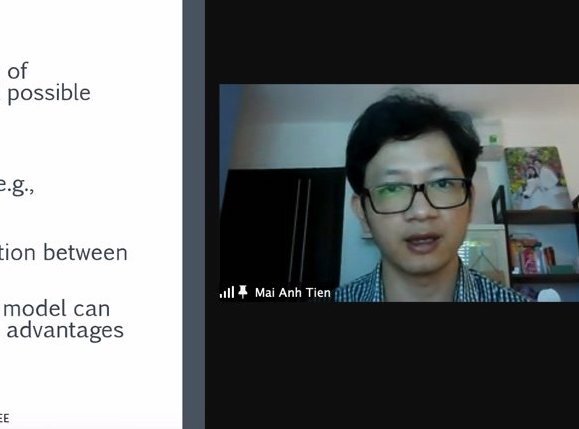
|
|---|
Research Presentation #2:
"The choice problem on land ownership described by the recusive logit model families"
Risa Kobayashi (University of Tokyo)
|
Her research is about land ownership behavior models considering decision dynamics and interaction. The study aims to understand landowner's behavior well, extend the RL model, and broaden its applicability. First, she explained how to digitize old paper-based Cadastre data and convert them to trajectory data. Then, she introduced the dynamic land-owning pattern choice model based on a dynamic discrete choice model. The landowner's decision history is regarded as state choice paths. The value function is calculated by backward induction, and the model is estimated by MPEC to reduce calculation costs. The likelihood ratio is sufficient for the whole period. We can interpret the time discount rate and parameter values of the different periods. In the discussion, the way to model the actual situation of land acquiring patterns, estimation method, and calculation cost are discussed with Dr.Oyama and Dr.Mai. |

|
|---|
Research Presentation #3:
"The Recursive Migration Choice Model after the Great East Japan Earthquake"
Rena Koseki (University of Tokyo)
|
She models residential choice behavior after the Great East Japan Earthquake using the RL model. On a macro-scale, victims moved to a larger city located closer to their hometown. On a micro-scale, she revealed that each person experienced dynamic residential choices influenced by their situation, such as life stages, the progress of reconstruction, and subsidy. She formulated these dynamic residential choices as discounted recursive logit model, where the residential state is defined by time, location, and family structure. Estimation results showed that distance between cities is the most important factor. She is now trying to estimate the time discount rate of different types of residents because it is insightful when analyzing decision-making after disasters. In discussion, the meaning of using the RL model, the importance of capturing victims' heterogeneity, and an estimation method are discussed with Dr. Mai, Dr. Hara, Dr. Oyama, and Prof. Hato. |

|
|---|
#11: "Living With Water"(Aug. 29, 2019)
In this seminar, we invited architect David Waggonner and landscape designer Keiji Asakura.
Waggonner and Asakura introduced landscape design and urban planning whose concept is "living with water." This concept is based on Dutch city planning and it aims at high disaster resilience considering the character of each city.
Lecture:
"Living With Water"
David Waggonner (WAGGONNER & BALL) and Keiji Asakura (Asakura Robinson)
They explained various projects around the US and even in India, which they have been working on, to direct the reconstruction process to ‘living with water’. During the planning process, they conduct field works and discuss the future of the city with different stakeholders such as developers, house owners and NPOs, to find local problems and realize the projects. This is supported by the Dutch government and influenced by the idea of ‘Dutch Dialogue’. Although proposals are various depending on the regional demography, soil, natural resources, land level of the downtown or the scale of existing infrastructures, the common concept is integration of nature and living, bringing back the natural system. They give up depending on huge infrastructures such as dike and sea wall, and create a small infrastructure system of the scale of neighborhood. We should think again what the value is and where to invest.
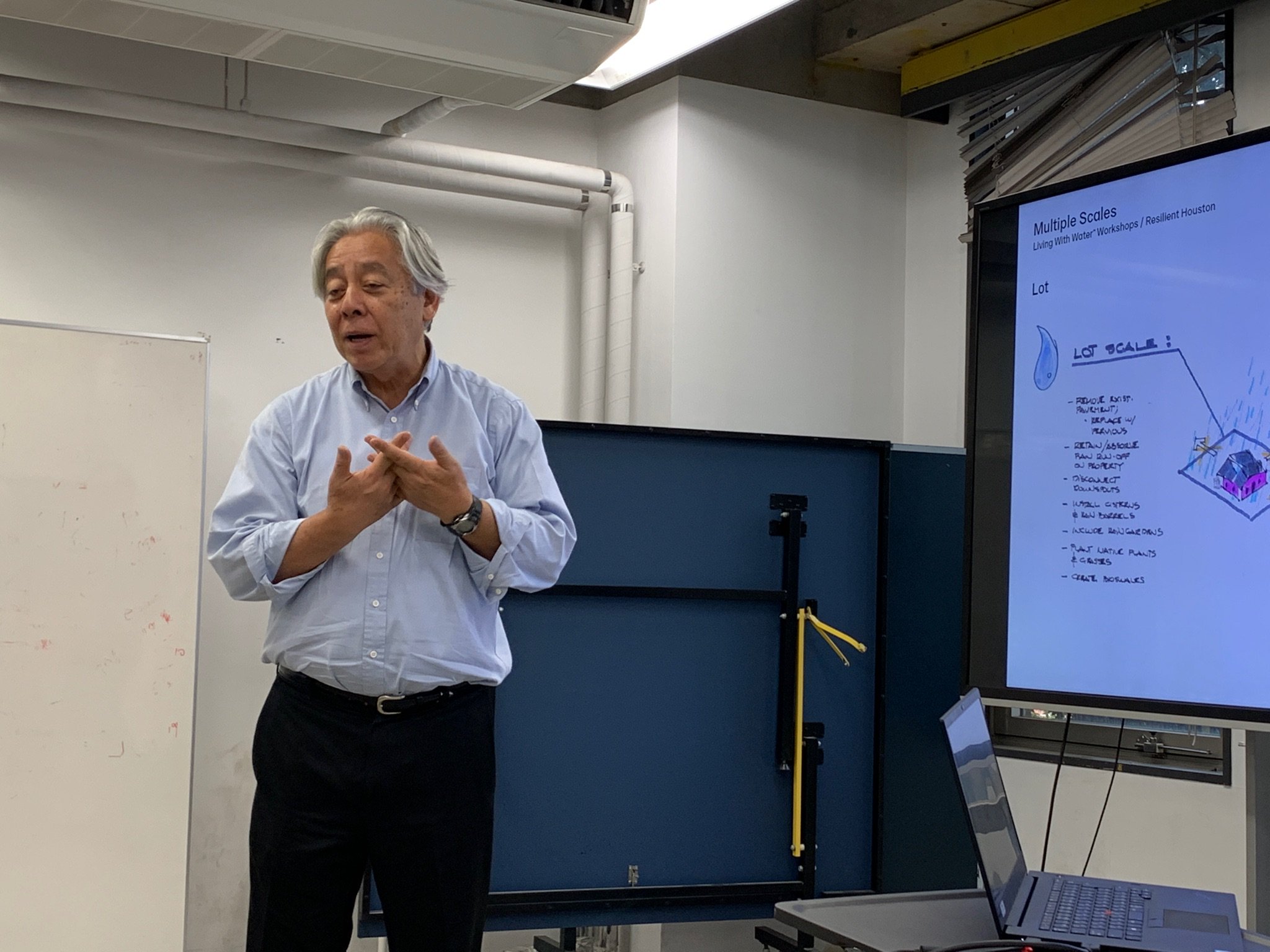 |
 |
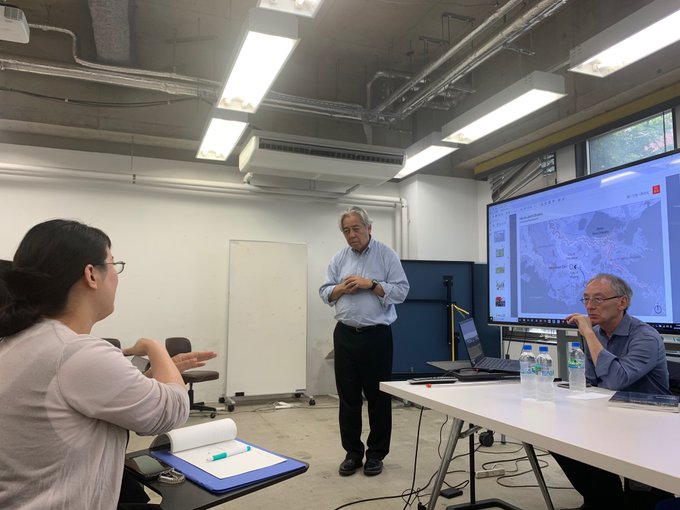 |
|---|
#10: "Unsteady Behavior Modelling in Damaged Networks" (Feb. 28 - Mar. 2, 2018)
In this seminar, we invited Prof. Shlomo Bekhor, Tomer Toledo, and some students from Israel Technion.
Our research program aims to develop multi-scale behavioral simulation and optimization of disaster management. In International Research Workshop, we would like to discuss our plan and agenda for studies of unsteady behavior modelling in damaged networks.
Research Presentation #1:
"Introduction"
Eiji Hato (University of Tokyo)
|
As an introduction of the international research workshop, Prof. Hato started with the example of the gridlock phenomenon which occurred just after The Great East Japan Earthquake, in Tokyo metropolitan area. In the collaborative research with Mr. Oyama, they conducted an analysis on the drivers' behavior in damaged networks. In such a context, drivers have little spatial information and tend to choose routes shortsightedly. In order to model these decision-making dynamics, they proposed a discounted recursive logit model. Also, he introduced on-demand routing optimization method using network contraction, which will contribute to the new transportation system in the depopulated areas. He concluded that route choice model with sequential discount rate is beneficial for understanding the decision dynamics in unsteady networks. |
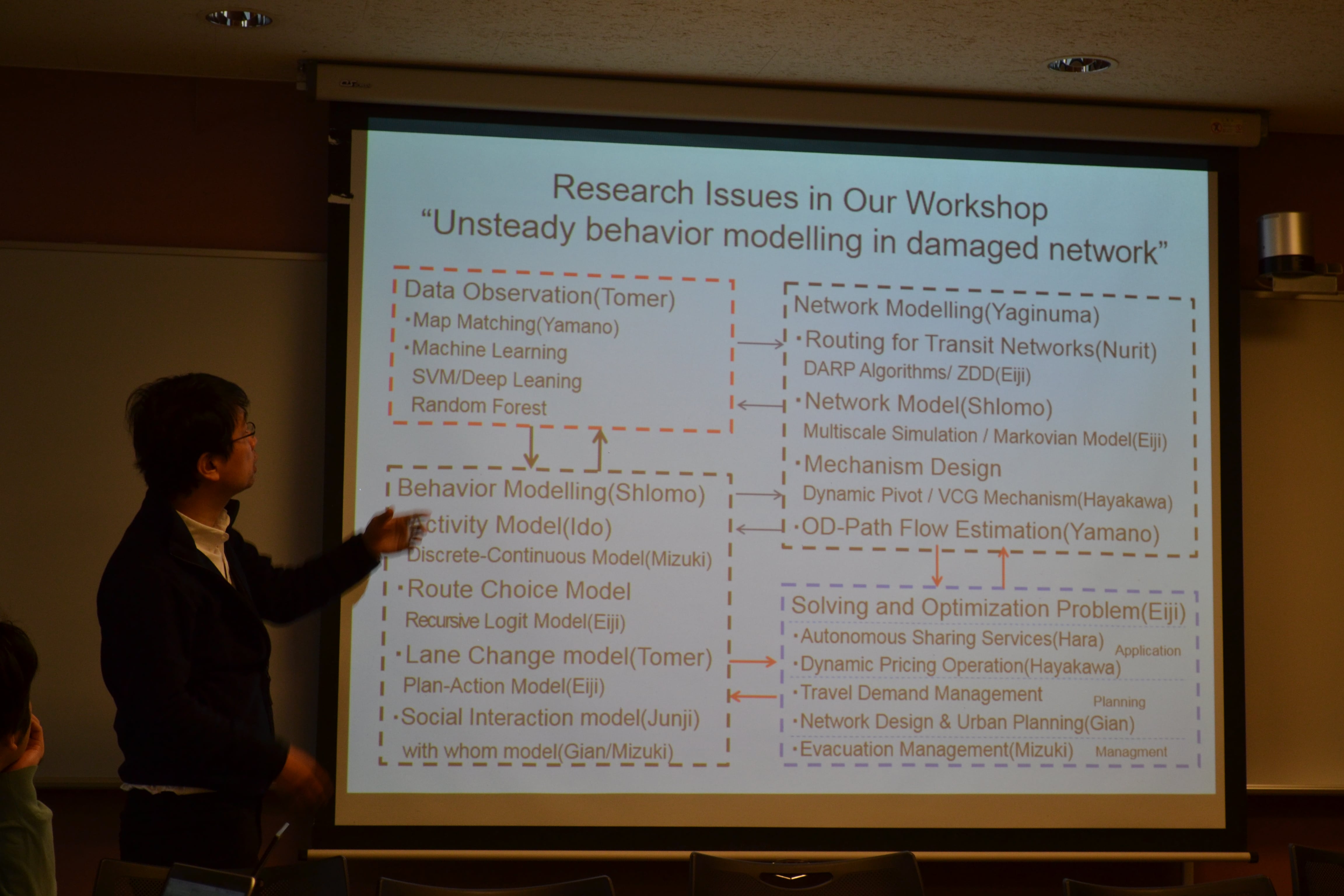
|
|---|
Research Presentation #2:
"Accounting for spatial correlation in tsunami evacuation destination choice"
Giancarlos Troncoso Parady (University of Tokyo)
|
He analyzes the tsunami evacuation destination choice process, using the Spatial Correlated Logit model. He conducted a case study of the Great East Japan Earthquake based on the data collected from Kesennuma city, in Miyagi prefecture. In order to describe an understudied aspect of the evacuation process, he improved SCL model so that it can account more accurately for spatial correlation among alternatives. The results suggest the existence of a high degree of correlation among unobserved attributes of zones, and empirical findings suggest that factors such as OD distance by mode, OD altitude difference, number of buildings and number of officially designated shelters are statistically associated with evacuation destination choice. Also, and from a theoretical perspective, it addresses the issue of spatial correlation in discrete choice models. A spatially correlated logit model is estimated, where the allocation parameter is specified as a function of proximity and inter-zone altitude difference to capture more adequately unobserved similarities among alternatives in the specific context of tsunami evacuation, and the proposed model yielded better statistical fit than the traditional MNL. |
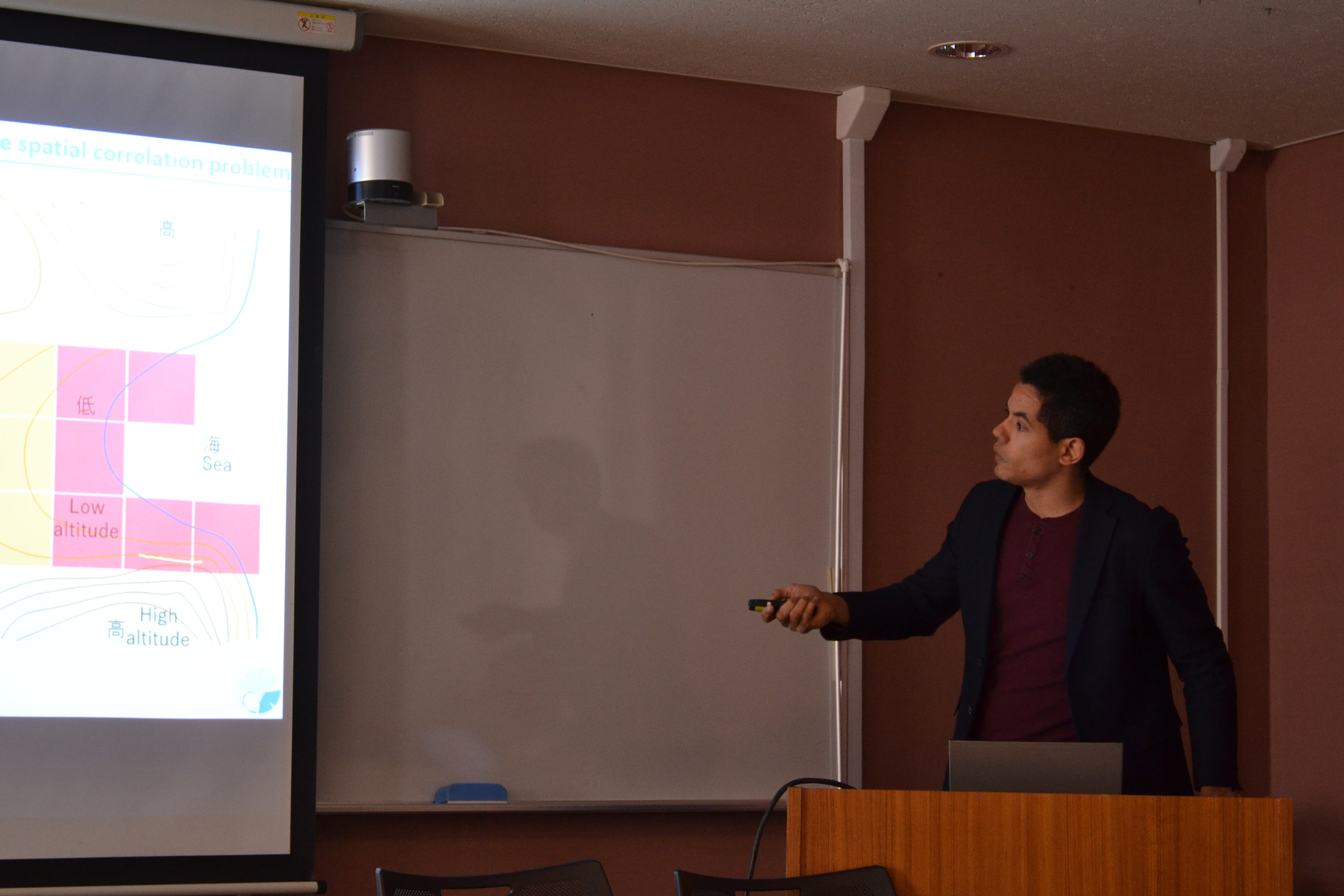
|
|---|
Research Presentation #3:
"Dynamic discrete-continuous models for evacuation behavior analysis"
Mizuki Ueda (University of Tokyo)
|
For the pre-disaster planning, it is necessary to understand evacuation activity. Under the Great East Japan Earthquake in 2011, some irrational evacuation behaviors were observed in the trip data collected from survivors in Rikuzentakata-city. But in the current evacuation models, they do not consider time constraints and future utility, and time is regarded as "timing", although in an emergency situation it should be considered as "resource to use". In order to model the evacuation behavior more accurately, she introduced Dynamic Discrete-Continuous Model and improved the former model by incorporating 2 new points: Time Discount Rate Beta and Time Constraints. She conducted a case study in Rikuzentakata-city, using survey data collected in 2012. The main findings through the estimation are threefold. First, elderly people are more likely to choose evacuation and their evacuation time is short. Second, people living closer to the coastline are likely to finish all activities immediately but people living far from the coastline tend to evacuate later, which signifies the demand for evacuation overlaps near the shelter. Third, in the evacuation behavior, time discount rate becomes smaller than in ordinary situation. |
Research Presentation #4:
"Modeling convergence enhancement of social interactions for evacuation"
Junji Urata (Kobe University)
|
Focusing on the interaction generated at the time of disaster situation, he clarified how much the interaction influences the decision to evacuate. He improved network formation model in order to describe a network formation in a small village under the disaster risk, and he formulated interaction in a small community by introducing Cross Nested Logit model (CNL). After that, he evaluated the influence on evacuation timings using local interaction model, while considering the positive & negative interaction between a robust person and a weak (disabled or elderly) person. In the formulation of an evacuation model, the utility function contains social utility which is defined by a human network and weight of interaction, and here, the weight of interaction can catch the asymmetric (altruistic) interaction between a robust person and weak person. He also carried out a case study in the mudslide case in Niihama city, occurred in 2004. The estimation result suggests that evacuation alert for the weak from rescue and number of the direct interaction encourage their evacuation and the robust people hesitate to evacuate before the weak evacuate. Through numerical simulation, he had two suggestive conclusions. First, staying trends will be amplified by gathering people who have low evacuation probability. Second, evacuation of a weak person has a positive impact on others' evacuation because the robust are able to start their evacuation. |
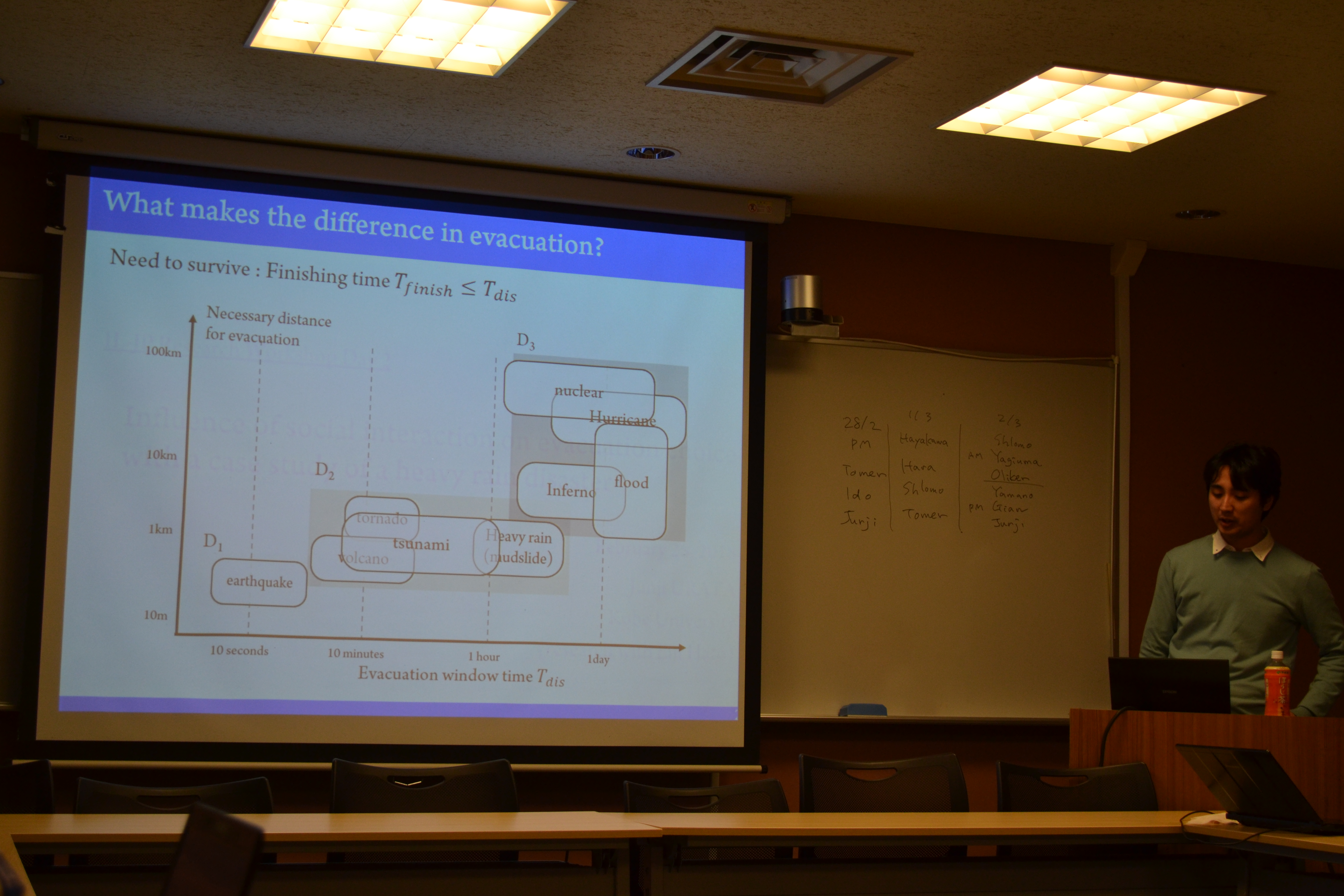
|
|---|
Research Presentation #5:
"Data collection and modeling for Haifa wildfires evacuation"
Tomer Toledo (Israel Technion)
|
Tomer began his presentation with the introduction of the precedence research on evacuation behavior and explained about the Haifa fire event which occurred on November, in 2016. He conducted a web-based survey to collect information about the evacuation. Based on the information, he estimated binary evacuation choice model. The result shows that people who live with children under 12 are more likely to choose evacuation. In addition to that, the strong social network effect is observed because there was strong tendency to travel together to the shelter. |
Research Presentation #6:
"Activity-based modeling for evacuation scenario"
Ido Marom (Israel Technion)
|
Ido talked about his preliminary research on activity patterns and intra-household interactions in evacuation behavior, he aims to implement activity-based models for disaster, while focusing on intra-household interactions during the evacuation. In Haifa fire (2006) case, he carried out some preliminary analysis and there was a big difference in behavior between adults with children and adults without children because adults with children tend to make more stops to pick up their children, therefore, it is necessary to consider intra-household interactions. |
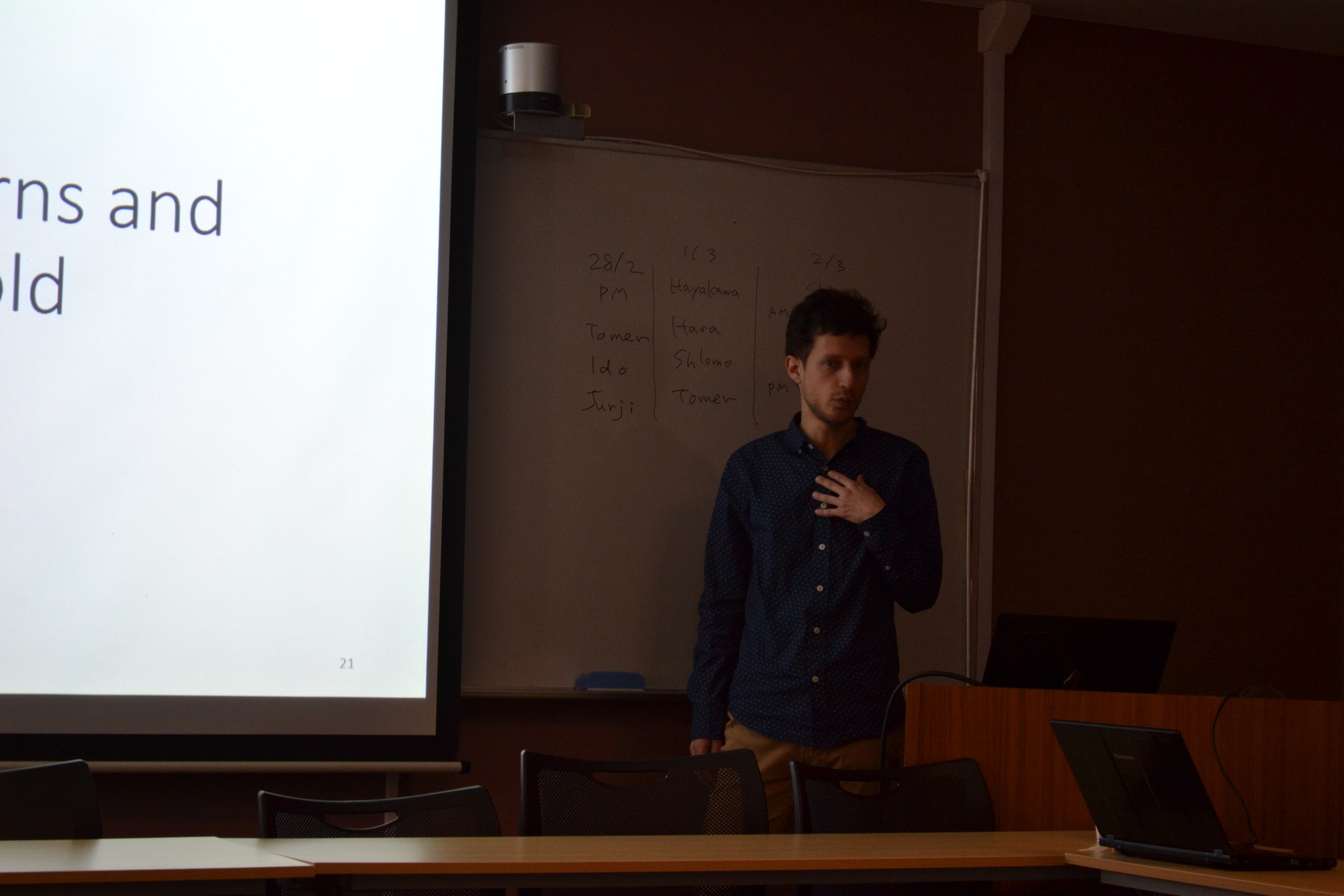
|
|---|
Research Presentation #7:
"Frequency-based transit assignment model that considers online information"
Nurit Oliker (Israel Technion)
|
In the presentation, she developed a frequency based transit assignment model considering that online information of predicted arrival times is available to passengers. Some public transportations have introduced technologies which informs the passenger of predicted arrival times, and transit assignment plays an essential role in planning and management of transit networks. The methodology is considering two types of available online information: (1) full, where the arrival times are available for all intermediate stops in the candidate paths, and (2) partial, where the arrival times are available at the boarding stop only. Passengers are assumed to consider the estimated arrival times together with the expected travel time when choosing their path. The assignment procedure includes the finding of attractive paths, setting of route choice decision rules for different cases of predicted arrival times, and the probability calculation for these different cases. The developed model is illustrated by an application for the Winnipeg network. In comparison to the well-known optimal strategies method, the suggested model produced significantly different assignment results and a notable reduction in the total travel time. The results demonstrate the potential impact of online information on travel behavior and route choice and emphasize the need for its consideration in planning models. |
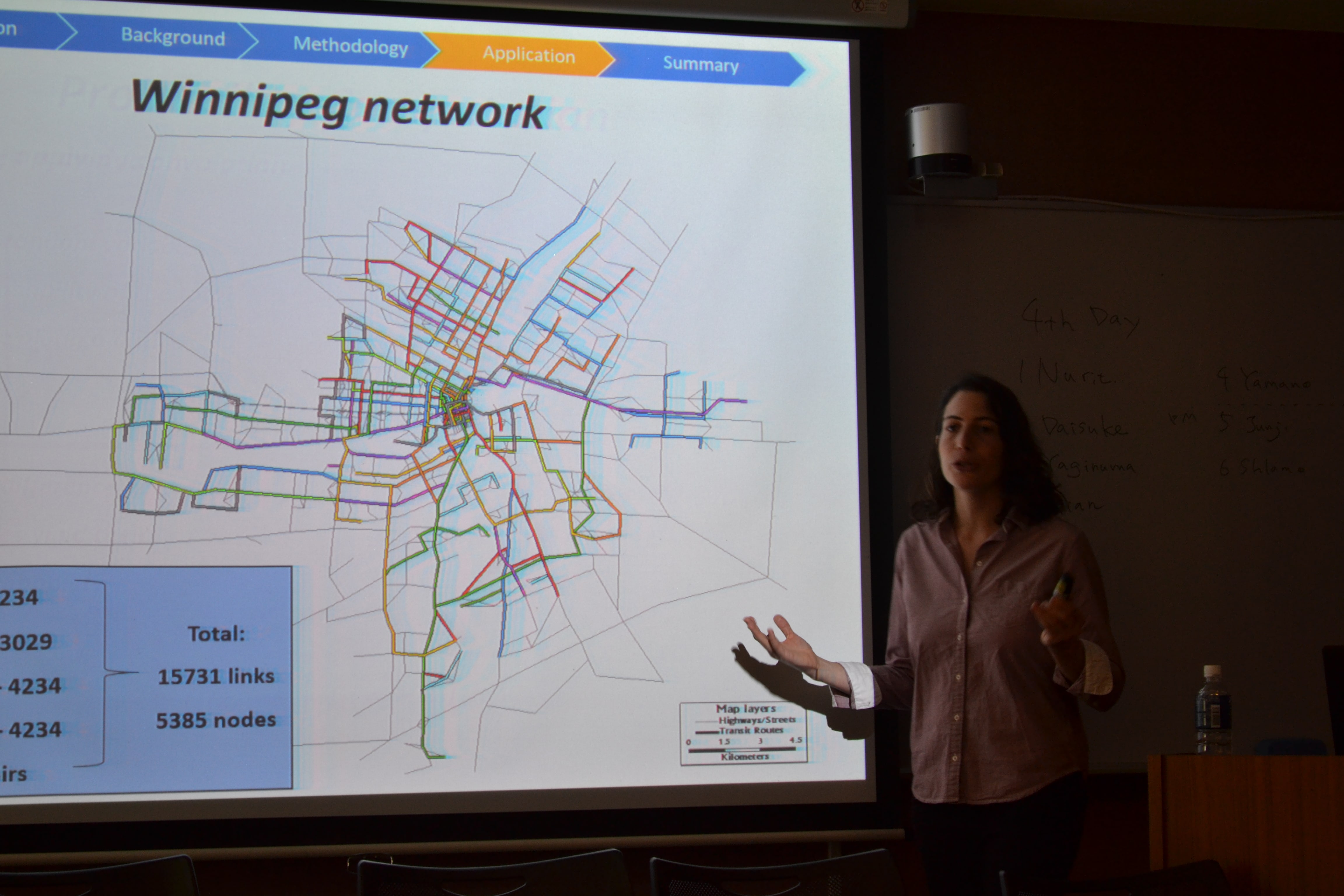
|
|---|
Research Presentation #8:
"The effect of seawalls on tsunami evacuation departure time"
Giancarlos Troncoso Parady (University of Tokyo)
|
Mr. Parady introduced his research “THE EFFECT OF SEAWALLS ON TSUNAMI EVACUATION DEPARTURE TIME: A CASE STUDY OF THE 2011 GREAT EAST JAPAN EARTHQUAKE”. Using data from a survey of survivors of the 2011 Great East Japan Earthquake and Tsunami, he evaluated quantitatively the effect of seawalls on evacuation departure time. A mixed effect Cox proportional hazard model was estimated, using time-dependent covariates to account for the changing nature of tsunami risk. Findings suggest that on average, the presence of an effective seawall (defined as a seawall higher than the forecast tsunami height at any given time) delays evacuation by 29.8%. Furthermore, irrespective of forecast tsunami height, higher seawalls were associated with 11.6% and 15.2% delays in departures for walls of 4 to 8 meters and over 8 meters, respectively. These results provide quantitative evidence of the existence of a false sense of security deriving from the presence of seawalls, a hypothesis that to the best of the authors’ knowledge has only been discussed qualitatively. Given that timely evacuation is one of the main factors affecting survival probability, the effect of seawalls on evacuation delay or non-evacuation is an important policy consideration. |
Research Presentation #9:
"An optimization for dynamic strategy of evacuation picking-up behavior"
Junji Urata (Kobe University)
|
Mr. Urata introduced an optimization approach for the dynamic strategy of evacuation and picking-up behavior to respond to tsunami risk. He started by suggesting that preparation and “pick-up” behavior is an important factor of evacuation delay in the 2011 Great East Japan Earthquake. His research purpose is to propose an optimal dynamic strategy for reducing the evacuees’ risk with a pick-up behavior. Assuming that a liner city and simple network, he estimated the risk evaluation, He showed dynamic control for picking-up behavior on bottleneck intersection. Because of some people who take a risk and pick up their family members, congestion can occur. A deductive and sequential approach to reach an optimal dynamic strategy with a low computational cost was proposed. He indicated that using simple control approach which shows just a stop timing, evacuees can understand easily. |
Research Presentation #10:
"Network reliability analysis under disaster situations in Shikoku"
Hideki Yaginuma (Tokyo Science University)
|
As a recent research, Mr. Yaginuma proposed a road evaluation method in the case of a disaster. He began with introducing that earthquakes can occur in various places in Japan, participants from Israel were very surprised that disasters were predicted over a wide area. Cost by Benefit evaluation norm is usually used in Japan, but this norm considers only normal everyday life and the emergency road vulnerability is ignored. He insisted that the evaluation of connectability is important and developed two new models. He calculated the log sum variable for the OD pair, calculated travel time, and evaluated road network. First of all, as a simple case, he showed an example result assuming that the vulnerability of the road is distributed. Next, taking into consideration the shutdown risk of roads and bridges endangered by Tsunami or other disasters, he applied it to actual highway network and showed the result. |
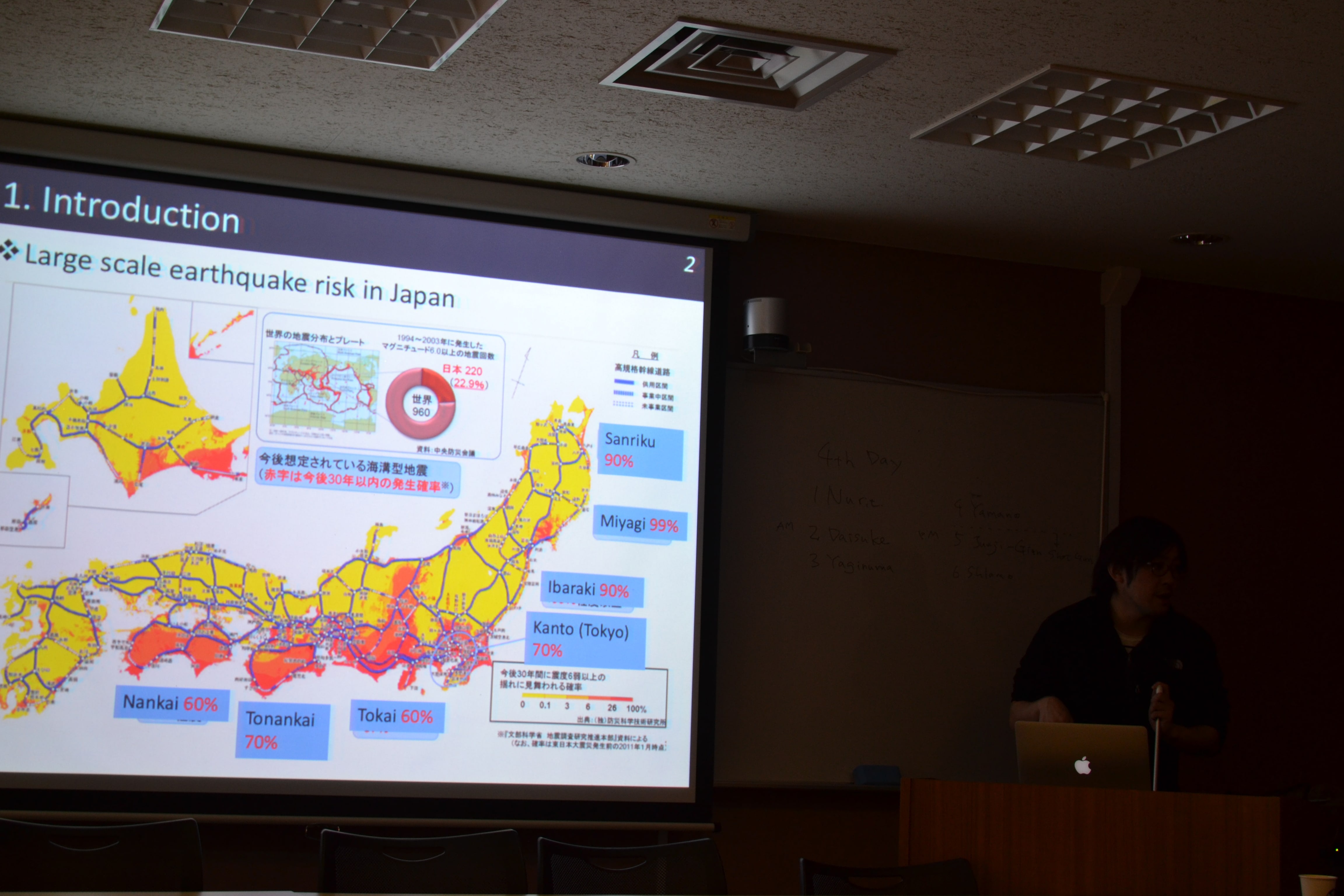
|
|---|
Research Presentation #11:
"New approach of travel behavior analysis based on probe data"
Issei Yamano (University of Tokyo)
|
Mr. Yamano talked about Probe Person (PP) technique using GPS. He showed an analysis about the walking speed based on PP technique. And then, he introduced new approach of travel behavior analysis based on information theory using sensor data and PP data simultaneously. He showed the experiment of OD demand estimation and suggests the difference between including error and error-free in measurements. His model will be able to take into account various error in measurements, sampling, and estimation. |
Research Presentation #12:
"Network design problem considering travel time and safety"
Schlomo Bekhor (Israel Technion)
|
His presentation theme was “Network Design Problem considering system time minimization and road safety maximization”. For network design, various kinds of problems need to be solved. We decide the objective function on upper level considering and the user equilibrium on a lower level. Also, we have to estimate the system time of different project combinations. He presented a solution for the multi-objective NDP. The objective criteria were minimizing the system time and maximizing the safety in the network. The model was applied for a large set of candidate projects on a real-size network, which demonstrates its ability to provide solutions for real problems. Since the crash prediction model is location-specific, implementation of the model on different networks will necessitate the use of alternative CPM. In order to find the Pareto front, the multi-objective optimization NSGA-II was used. No major differences were found using different population sizes. |
Research Presentation #13:
"Optimization of operations control of public transportation networks"
Tomer Toledo (Israel Technion)
|
Mr. Toledo proposed real-time control for transit systems with transfers. These days, because integrated public transportation systems improve delay, new real-time operations control is required. The road was assumed to be under single line control or multiple lines control. In each case, he showed the result of the case study. He developed a system for real-time transit control based on a prediction. In multiple line case, he set optimization problem to investigate the total delay in the system. He assumed the speed and holding time constraints. Considering holding and speed change, this approach accounts for transfers and vehicle capacities. Moreover, the transit can be evaluated as on-going against no and headway control. As next steps, he was trying to improve the predictions and the robustness. |
Research Presentation #14:
"Fast Enumeration Method of Travel Route of Drt Using Zero-Suppressed Binary Decision Diagram"
Daisuke Yoshino (FUKKEN CO.,LTD.)
|
He introduced his research about methods for demand transportation and public transport (bus) operation plan. In order to enumerate solution patterns to the demand plan of the demand transport, he proposed a method using ZDD. First, he expressed the operation route of demand traffic by a graph structure and enumerated all subgraph structures satisfying certain constraints from the given graph structure. Next, using compressed ZDD structure, it is possible to get not only the best solution but also other good solution. In the traditional method, only the best solution was obtained. However, in the actual planning, the best solution may be unable to run. Therefore, he suggested that this approach would be useful for traffic planning under such circumstances. The usefulness was confirmed in a case study. In the bus operation plan, we have to consider fairness and economy of the plan together. He proposed an evaluation model that quantifies the potential public transportation demand by sub-district within a municipality based on DEA and clarifies concrete benchmarks in the district. In addition, he applied the developed model to the actual city and examined the district to focus on promoting the use of public transportation. |
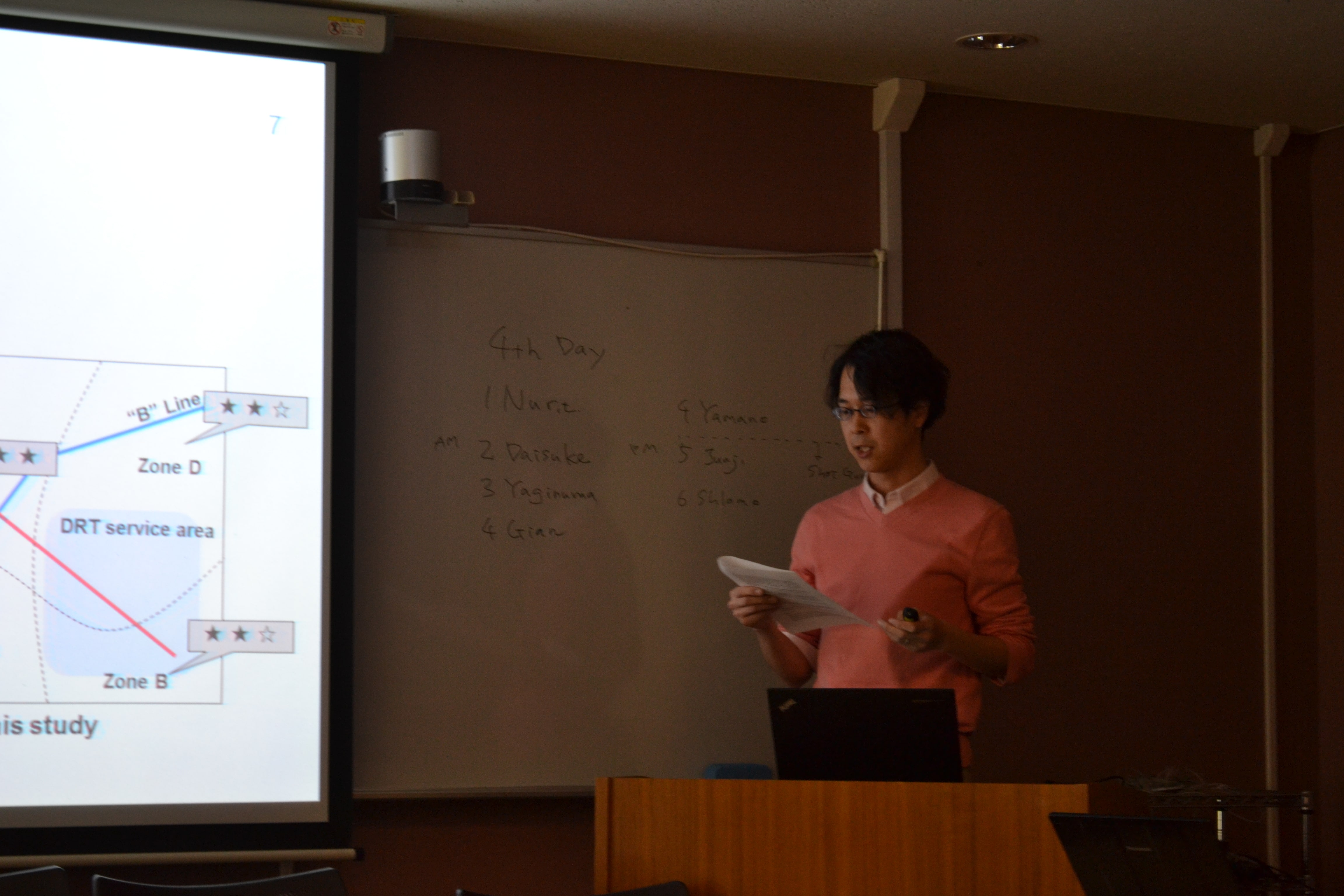
|
|---|
#09: "Autonomous Vehicles Modelling and its Network Evaluations" (Mar. 1, 2018)
In this seminar, we invited Prof. Schlomo Bekhor, who is a specialist in travel behavior modeling.
We had the discussion about "Autonomous Vehicles". It consists of the presentations by four researchers related to network assignment, optimization, and simulation.
Research Presentation #1:
"Connected Car and New Mobility Service Implication"
Kayoko Hara (Nissan Motor Co.)
|
Ms. Hara introduced "Easy Ride" which is the autonomous drive vehicles service developed by Nissan & DeNA. This autonomous drive vehicles are set very accurate digital map and detect signals and obstacles. It enables users to move to where they want to go with the application. Before the field test at Minatomirai area in Yokohama city where there are many kinds of people (residents, tourist, and worker), she checked the market volume in this area using Person Trip data and the SP survey they conducted. She pointed out that this result is static and what they want to know is the demand changing dynamically. Then, how to manage and how to calculate the demand dynamically are very big issues. And social understanding is also a big issue. |
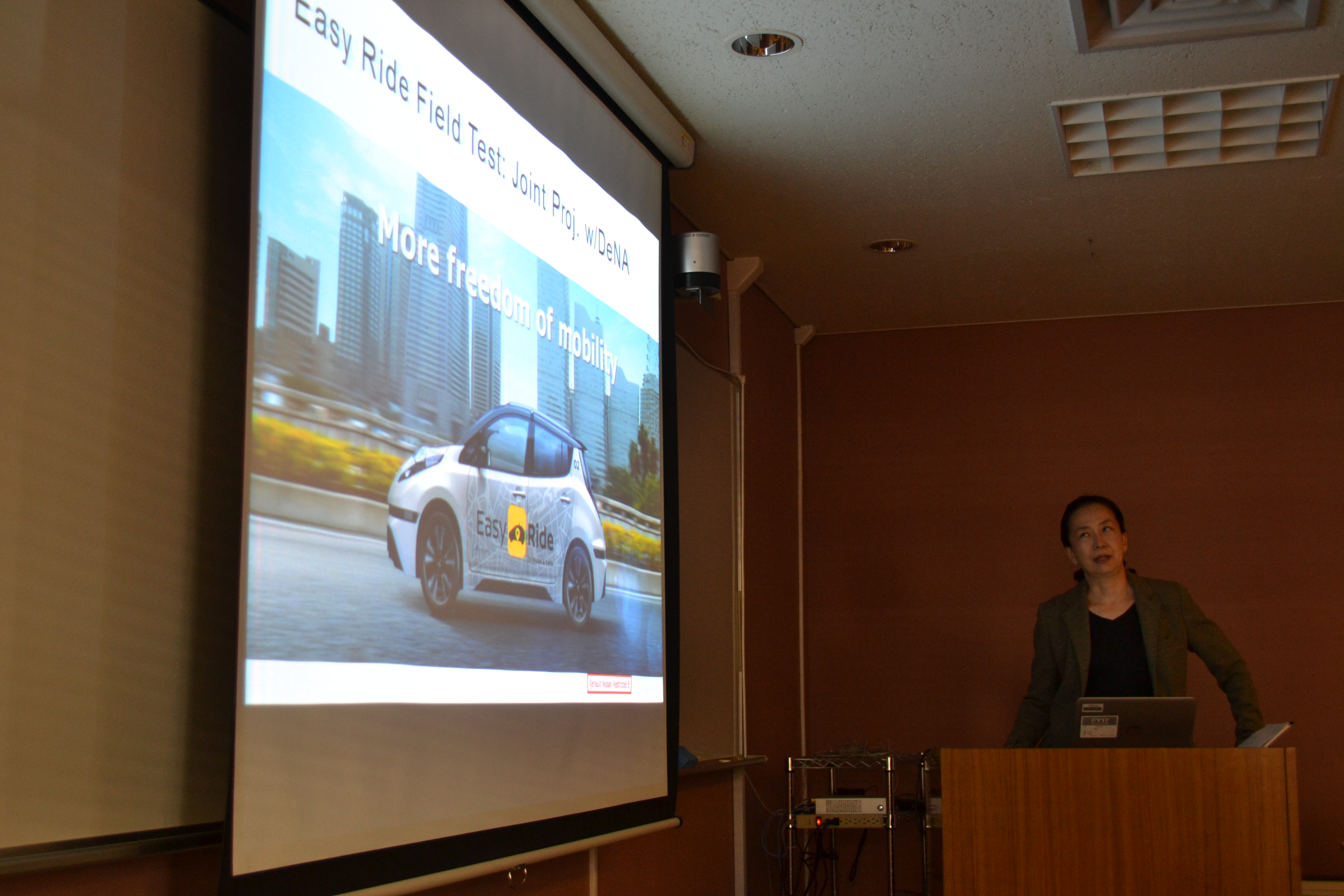
|
|---|
Research Presentation #2:
"Driving behavior modeling and simulation for autonomous vehicles"
Tomer Toledo(Israel Technion)
|
Professor Tomer introduced micro-simulation for developing Autonomous Vehicles (AVs) to evaluate expected effects on traffic flow, safety, and externalities. In the simulation, driving models need good algorithms for autonomous driving that is longitudinal-lateral movement. Then, there are some challenges that are how to set variants, how to treat sensing and communications, and how to idealize human driving in semi-AVs. They conducted the experiment in which they checked Adaptive Cruise Control(ACC) state and vehicles movement. Applying these data to Mixed logit choice model, they analyzed the relation between ACC transitions and some parameters. After that, they run a simulation to check the harmonic speed changing ACC and C-ACC penetration rates, demand level, and automated minimum leader headway settings. |
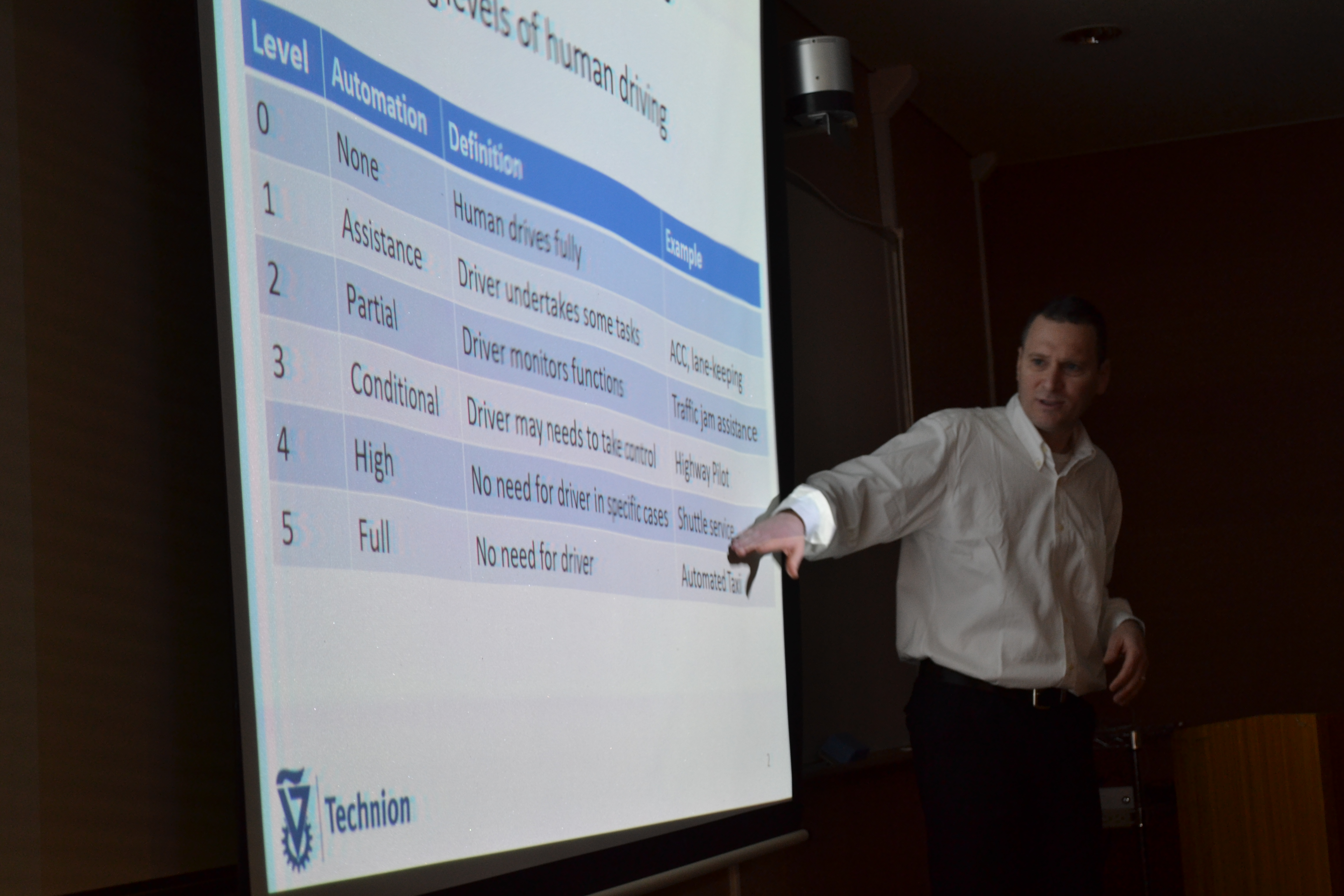
|
|---|
Research Presentation #3:
"Transportation network equilibrium in presence of autonomous vehicles"
Schlomo Bekhor (Israel Technion)
|
Professor Bekhor posed questions that are "How will autonomous vehicles and traditional ones coexist?" and "How will the introduction of autonomous vehicles affect travel habits in general and the mode choice in particular?" These questions include whether AVs will induce people to travel more and whether they will benefit. Each intermediate scenario which is the result of introducing AVs can be seen as a parametrized combination of User Equilibrium (UE) and System Optimum (SO). He proposed the methodology using the dynamic representation of the problem. The initial calculation based on it using MSA (multi-scenario approach) showed the different tendency of moving from UE to SO in each example network. |

|
|---|
Research Presentation #4:
"Connected vehicle auction and it's mechanism design"
Keiichiro HAYAKAWA (Toyota Central R&D Labs., Inc)
|
Mr. Hayakawa showed the traffic situations with AVs in which there are complicated interactions between the administrator, service operators, and customers. Then, he focussed on the sequential mechanism for a service operator that aims to maximize social welfare. There, the objective is to maximize social welfare which is defined as the summation of the users’ utility based on Activity model under time-space constraints of users and under capacity constraints of the road network. To solve the problem, he used ZDD (Zero-suppressed binary decision diagram) and MSA. In numerical study, he showed that his proposed mechanism can remain high efficiency when increasing the number of agents. Finally, he suggested that his mechanism can be easily extended to an auction-based implementation by which the social optimal states are achieved. |
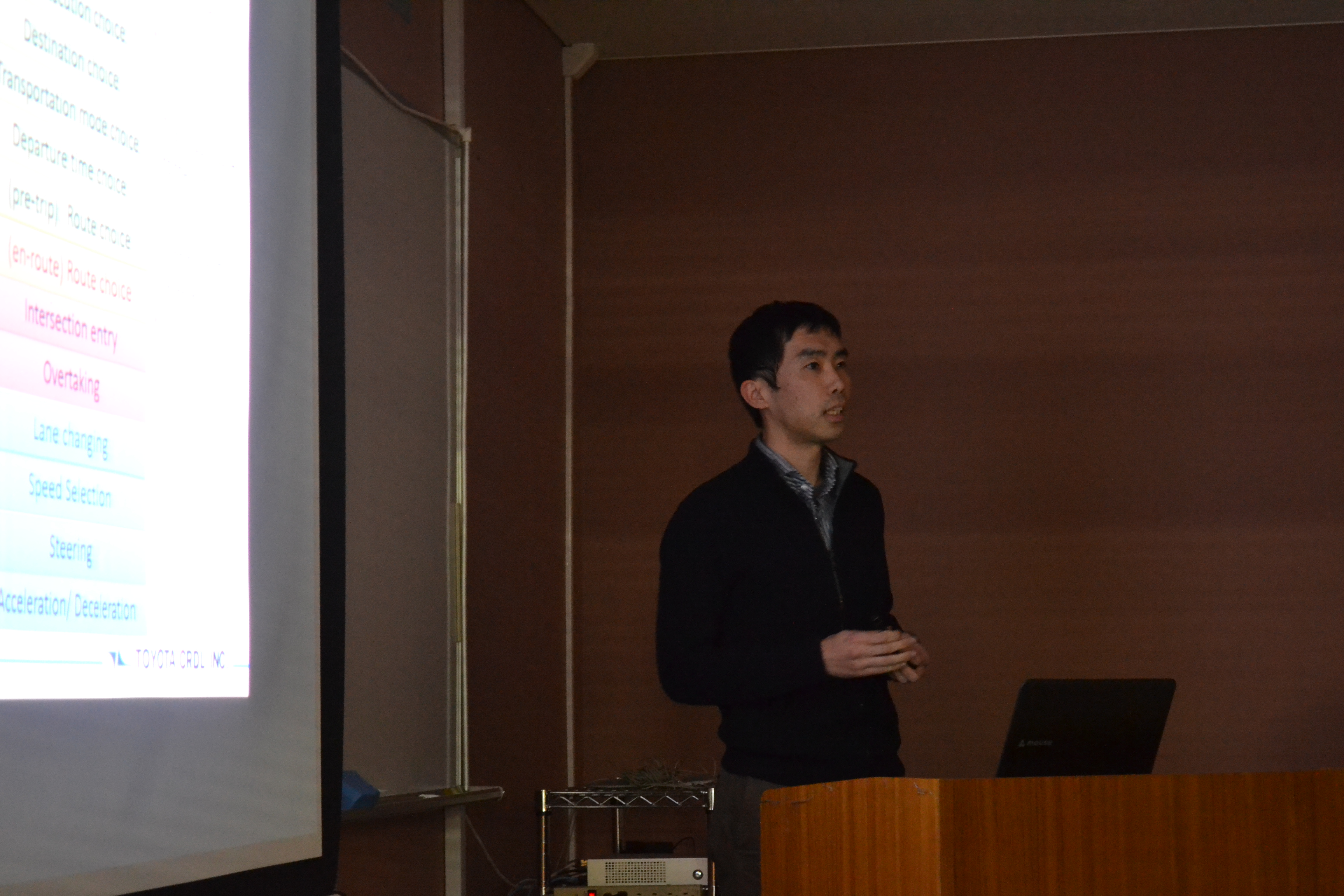
|
|---|
#08: "Behavior Models and Optimization"(Oct. 13-14, 2017)
In this seminar, we invited Prof. Michel Bierlaire, who is a specialist in travel behavior modeling.
In addition, we had "bahavior in Networks Research Workshop", where seven speakers had presentations related to behavior modeling. It consists of three sessions, route choice, optimization, and special research talk by Prof. Michel Bielraire.
Keynote Lecture:
"Behavior Models and Optimization"
Prof. Michel Bierlaire (Swiss Federal Institute of Technology in Lausanne) [PDF]
Professor Ben-Akiva gave us a keynote lecture regarding mainly to Smart Mobility applying a behavior model and optimization from concept to frameworks to case studies..
He presented a mobile data collection, a personalized correspondence using behavioral models, the improvement of efficiency in supply of mobility applying optimization, and an integrated smart planning composed of them as an important agenda in a new age of Smart Mobility. And concretely, he illustrated FMS that is a smartphone and prompted-recall-based integrated activity-travel survey using a combination of a smartphone app and an online prompted recall survey to collect both demographic and travel data from participants, FMOD that provides a personalized and optimized menu of travel options in real-time consisting of different modes with varying level of service including mini-bus, shared-taxi and taxi, MeMOT that designs, builds and trials a new system to incentivize people to adapt their travel choice to conserve energy using real and simulated personal travel data to reward people to shift their routes, departure times, modes of travel and vehicles based on live information they receive from MeMOT app and so on.
 |
 |
 |
|---|
Research Presentation #1:
"Route choice behavior under extreme weather events in densified networks: a case study in Tokyo under torrential downpour"
Samal Sanjeewa Darmarathna (University of Tokyo) [PDF]|
Travel behavior is changed under uncertainty. Especially, we focus on extreme weather events and research the route choice behavior during them in β-Scaled recursive logit model framework.Checking the data in Tokyo, we realize that travel time parameter increases indicating difficulty to assess difference of travel time in links during heavy rainy day, that sequential discount rate β decreases indicating tendency towards the myopic decision making behaviour, and so on. |
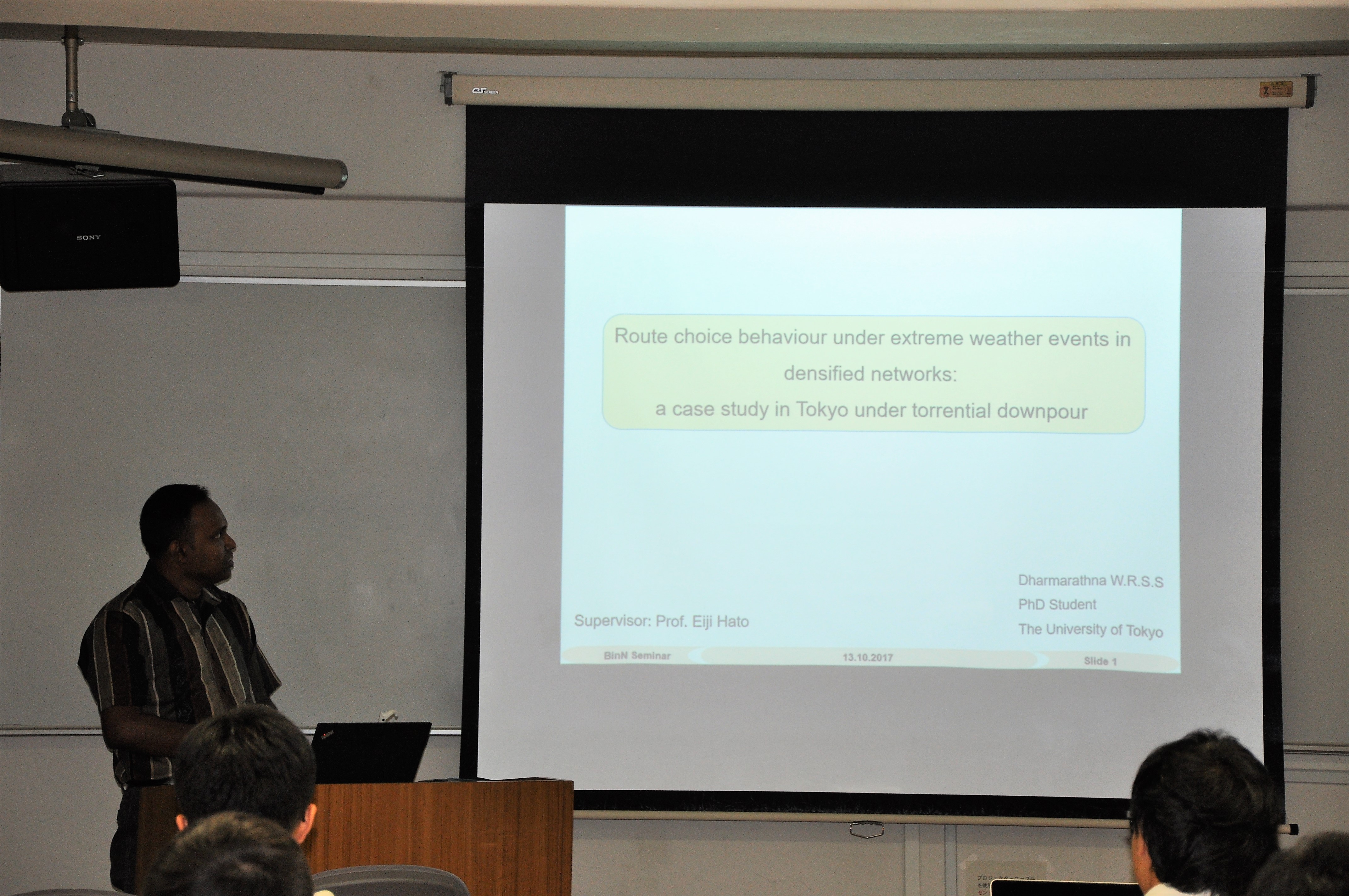
|
|---|
Behavior and Network Optimization Session 1:
"A strategy-proof mechanism of network pricing focusing on the activity-chain of agents"
Keiichiro Hayakawa (TOYOTA CENTRAL R&D LABS., INC.) [PDF]|
We establish fundamental algorithm to realize MaaS(Mobility as a Service) which allocate traffic resources optimally to users, considering heterogeneous users and slow traffic using auction-based approach. We have some problems to express this, but we introduce activity-state network which is an extended time-space network and time-constraint, and formalize activity-chain auction based on VCG mechanism. Moreover, We propose an algorithm, which is based on graph theory, to mitigate the computational complexity. Simulating based on this model, it can be said that by considering slow traffic, especially for cruising agents, the total social welfare can be increased. |

|
|---|
Behavior and Network Optimization Session 2:
"Reservoir-based Surrogate Modeling of Dynamic User Equilibrium Assignment "
Qian Ge (Tokyo Institute of Technology) [PDF]|
In Dynamic Traffic Assignment (DTA), we have to deal with Dynamic User Equilibrium(DUE), which is the assumption that the travel time of travels on all used paths is equal at user equilibrium in order to evaluate path cost. Firstly, variational inequalities formulation is adopted for DUE. However, this approach imposes high computation burden. Therefore, surrogate modeling is adopted to develop a DTA solver considering macroscopic traffic dynamics. It describes the mapping from path flow to path cost and can be viewed as a local approximation of mapping for the solution point. It performs better when the distance between sampled data and the solution are small. By iteratively solving the DUE problem, the accuracy of surrogate model will be improved accordingly. |

|
|---|
Behavior and Network Optimization Session 3:
"A macroscopic approach for optimizing road space allocation of bus lanes in multimodal urban networks through simulation analysis"
Takao Dantsuji (Tokyo Institute of Technology) [PDF]|
Transportation demand management (TDM) has problems that we cannot solve easily; congestion. Dedicated bus lane is regarded as one of the most promising solutions. In this study, road space allocation of the dedicated bus lanes is optimized quantitatively by using 3D-MFD (Macroscopic fundamental diagram). This approach adopts both static optimization model and simulation analysis model. In the Geneva case, around 15% of the space to the bus lanes is the most efficient. In the future study, it is useful to investigate the universality of this approach further with the Tokyo case, by improving the aggregate logit model or calibrating by the detectors data. |
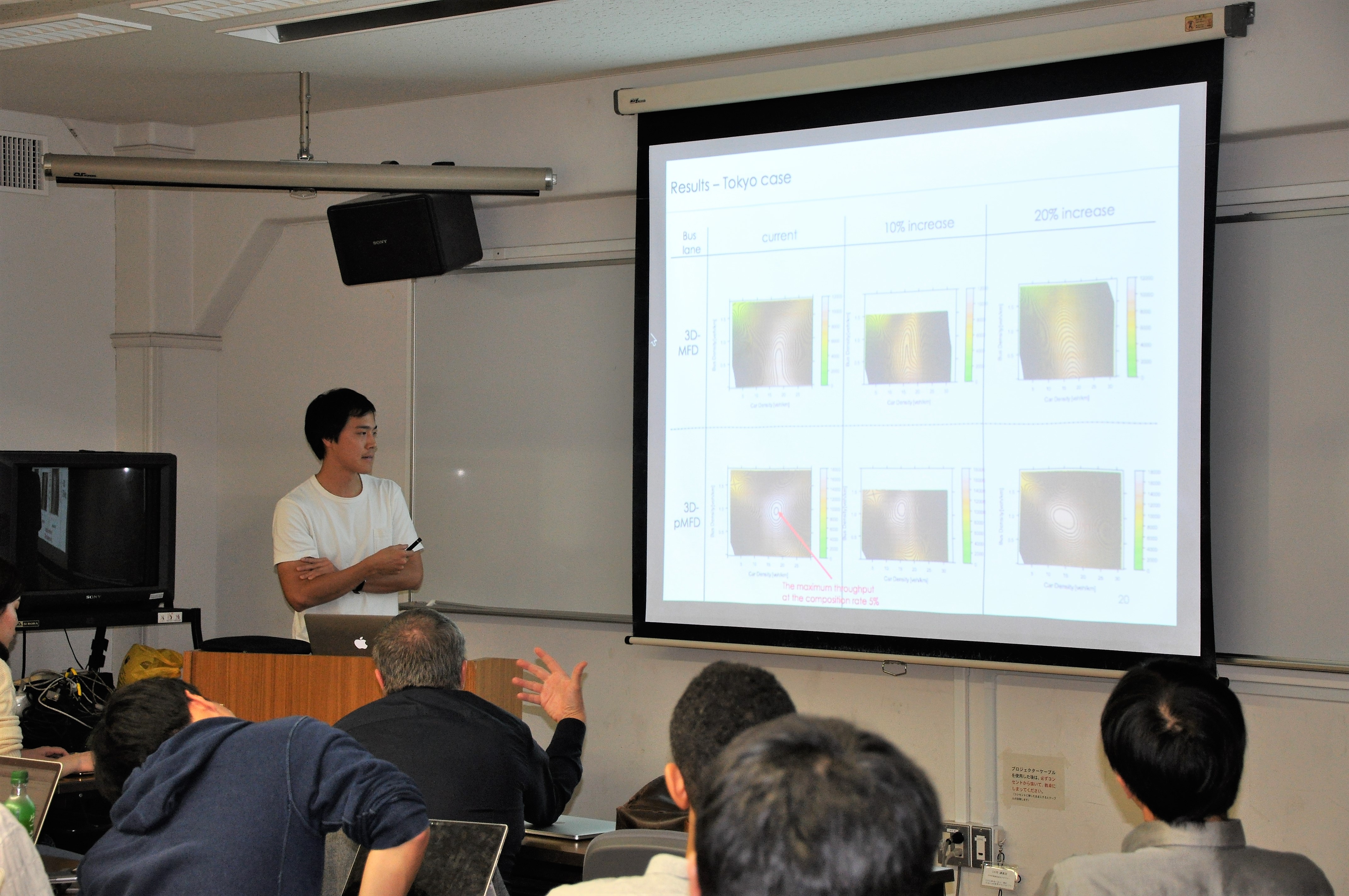
|
|---|
Special Research Talk:
"A macroscopic approach for optimizing road space allocation of bus lanes in multimodal urban networks through simulation analysis"
Prof. Michel Bierlaire (Swiss Federal Institute of Technology in Lausanne) [PDF]|
In this session, Prof. Michel introduced various ongoing research projects in EPFL such as the analysis of traffic system of Ghana, the analysis of behavior of pedestrian in EU, the technology for detecting pedestrian in autonomous driving, the optimization of a timetable of Swiss Federal Railways and so on. He finished it with an big project which aims at "World without Car" by installing the moving walkway throughout the city. At last, he gave an advice to young researchers that they pay attention to both updating technology and idea and problems in the world and match them. |
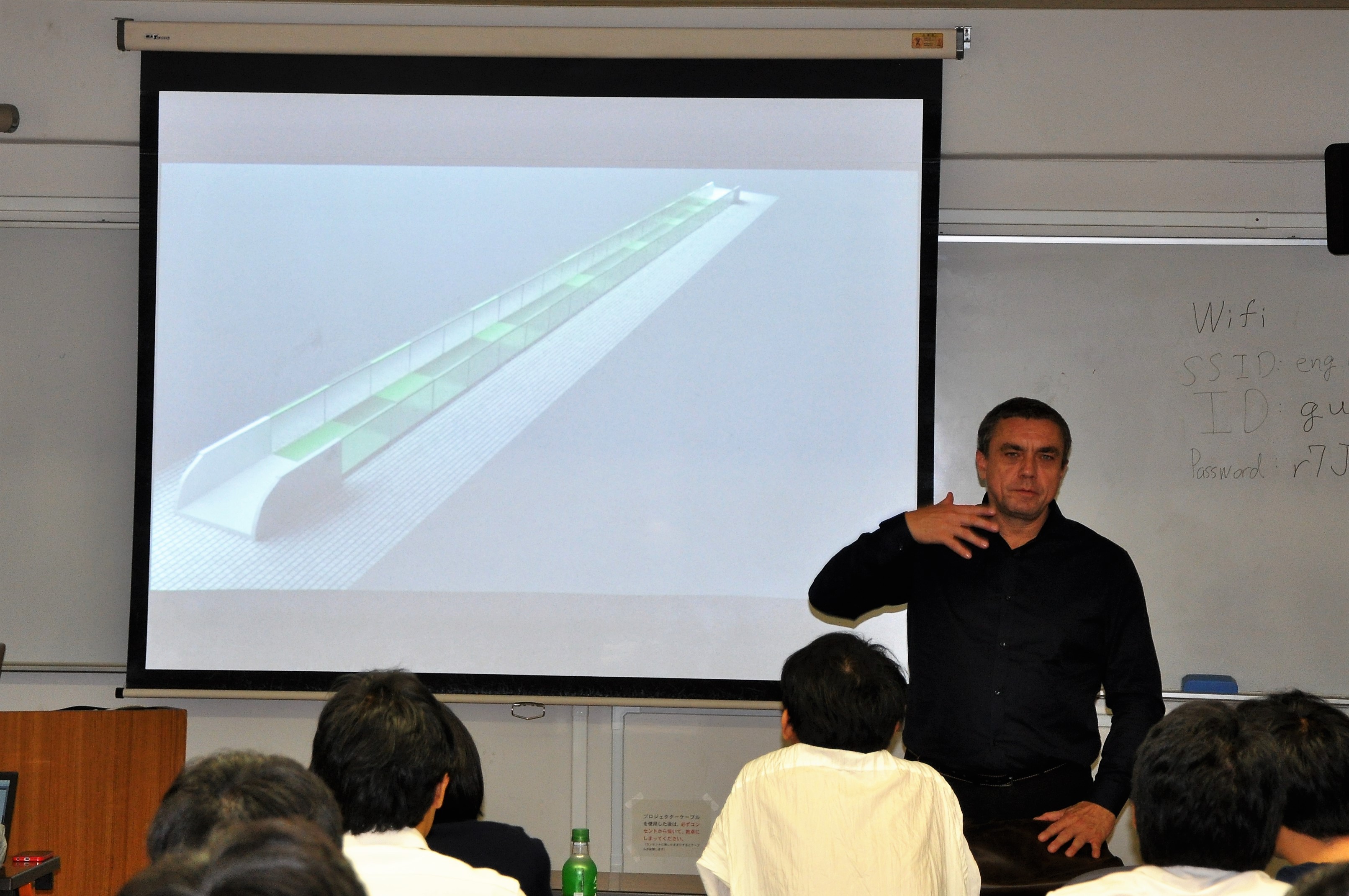
|
|---|
Early Bird Session 3:
"Structural Estimation for a route choice model with uncertain measurement"
Yuki Oyama (The University of Tokyo)[PDF]|
Mr. Oyama had a presentation about the route choice model estimated simultaneously with the route measurement model by GPS data. This approach is to resolve the 'loop' that the route choice data for estimating parameters of the route choice model is made by using parameters of route choice model and the assumption that error variance is constant among all links. Since estimating the proposed model corresponds to solving a fixed point problem, structural estimation method is applied. The effectiveness of proposed model and the estimation method is validated by twins experiments. When estimating parameters by using the real data, the dependency on each link of measurement error variance was shown. Also, the improvement of the estimation result was shown. As an example, travel time seemed to be significant from the result of one-way model while the arcade dummy variable was most likely to be significant and travel time was not significant from the result of structural estimation. |
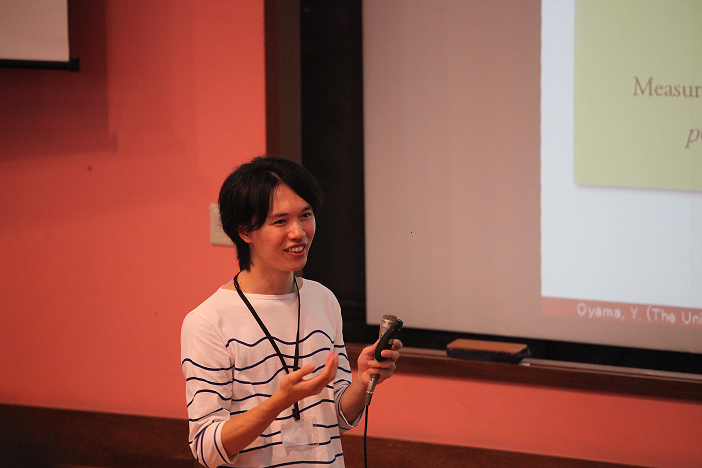
|
|---|
#07: "Dynamics in Behavior Modeling with Advanced Observation"(Sep. 24-25, 2016)
In this seminar, we invited Prof. Moshe Ben-Akiva, who is a specialist in travel behavior modeling and currently engaged in projects regarding smart mobility.
In addition, three young speakers had presentations related to behavior modeling. The first presentator Mr. Seo introduced a new method for conducting travel survey which enables long-term and extensive investigation. Next, Mr. Urata discussed a methodology of modeling tsunami evacuation behavior accounting for dynamics of heterogeneity in ecpected utility. Lastly, Mr. Oyama proposed a new link-based route choice model under uncertain measurement with structural estimation method.
Keynote Lecture:
"Smart mobility: Optimization and Behavioral Modeling"
Prof. Moshe Ben-Akiva (MIT) [PDF]
Professor Ben-Akiva gave us a keynote lecture regarding mainly to Smart Mobility applying a behavior model and optimization from concept to frameworks to case studies..
He presented a mobile data collection, a personalized correspondence using behavioral models, the improvement of efficiency in supply of mobility applying optimization, and an integrated smart planning composed of them as an important agenda in a new age of Smart Mobility. And concretely, he illustrated FMS that is a smartphone and prompted-recall-based integrated activity-travel survey using a combination of a smartphone app and an online prompted recall survey to collect both demographic and travel data from participants, FMOD that provides a personalized and optimized menu of travel options in real-time consisting of different modes with varying level of service including mini-bus, shared-taxi and taxi, MeMOT that designs, builds and trials a new system to incentivize people to adapt their travel choice to conserve energy using real and simulated personal travel data to reward people to shift their routes, departure times, modes of travel and vehicles based on live information they receive from MeMOT app and so on.
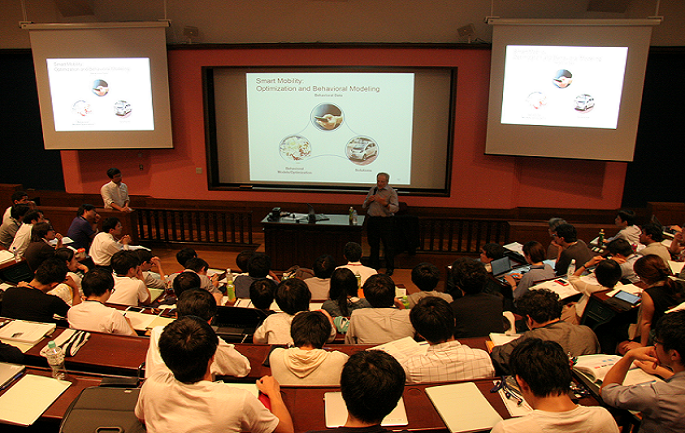 |
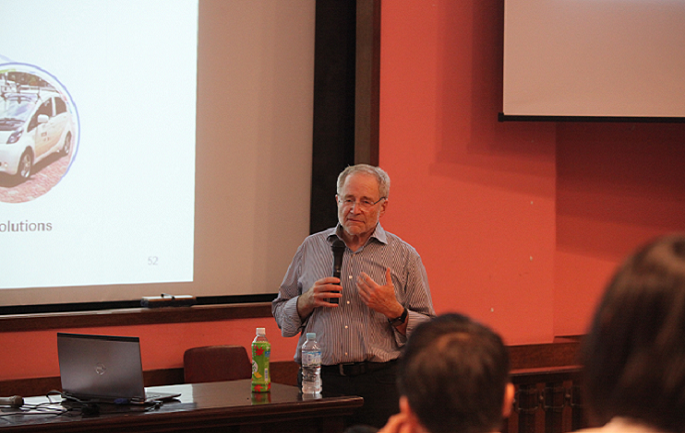 |
 |
|---|
Early Bird Session 1:
"Automated and Adaptive Activity-Travel Survey using Online Interaction with Travelers"
Toru SEO (Tokyo Institute of Technology) [PDF]|
Mr. Seo had proposed a new survey method for collecting travel data which is suitable for a long-term and extensive investigation. The proposed method estimates the type of the detectated activity, and questions to the traveler when the estimation confidence is lower than a particular rate. The most likely type of the activity and the estimation confindence are calculated from the historical data based on Naive Bayes assumption. The answer by the traveler or the estimated type of the activity is used as the traveler-specific historical data to the learning process of the model for estimation of the activity type. The proposed method is validated by using existing travel survey data. The error rate of the estimation stayed 5%, which is given by admin, and the frecuency of questions was almost halved after 12 days. The proposed method would be the survey method which reduces the burdan of travelers and keeps the quality of data high. |

|
|---|
Early Bird Session 2:
"Modelling of Tsunami Evacuation Behavior accounting for Dynamics of Heterogeneity in Expected Utility"
Junji URATA (Kobe University) [PDF]|
When we model the evacuation behavior, it would be important to acount for heterogeneity in expected utility and choices of the evacuation start time. Mr. Urata had formulated the sequential choice model in which a decision maker chooses to evacuate or to stay there at every term. The utility of staying at time t includes the expected utility when choosing to stay at time t (EV). In the evacuation situation the recognized expected utility would not be the same as the expected utility satisfying the Bellman equation, and may have some variance. Therefore, the new constraint Ω, the range of vairiance, is introduced. This model is validated by evacuation data in Rikuzentakata. The algorithm to estimate the model is constructed based on SQP method. The finel likelihood of the proposed model is higher than that of static model or dynamic model with no heterogeneity. Also, distribution of recognized expected utility in time and space was shown. |
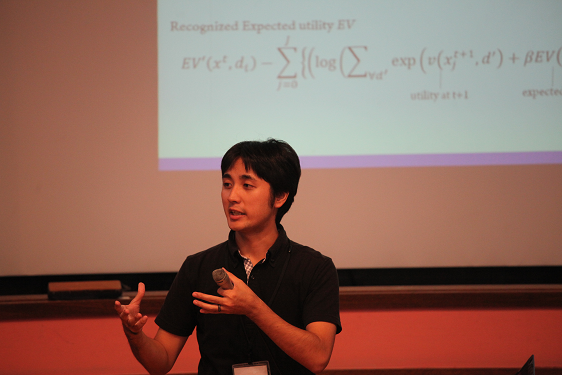
|
|---|
Early Bird Session 3:
"Structural Estimation for a route choice model with uncertain measurement"
Yuki Oyama (The University of Tokyo)[PDF]|
Mr. Oyama had a presentation about the route choice model estimated simultaneously with the route measurement model by GPS data. This approach is to resolve the 'loop' that the route choice data for estimating parameters of the route choice model is made by using parameters of route choice model and the assumption that error variance is constant among all links. Since estimating the proposed model corresponds to solving a fixed point problem, structural estimation method is applied. The effectiveness of proposed model and the estimation method is validated by twins experiments. When estimating parameters by using the real data, the dependency on each link of measurement error variance was shown. Also, the improvement of the estimation result was shown. As an example, travel time seemed to be significant from the result of one-way model while the arcade dummy variable was most likely to be significant and travel time was not significant from the result of structural estimation. |

|
|---|
#06: "Modeling for capturing the diversity and changes in knowledge information society"(Sep. 25-27, 2015)
In recent years, the Information Communication Technology (ICT) and transport technology have been revolutionarily developed, and the way of communication and travel behavior are dynamic changing. In this seminar, we invited Prof. Fujita, who is a specialist in economic field and currently doing research on diversity and creativity in Brain Power Society.
Keynote Lecture: Diversity and Cultured in Knowledge Creation
-The Story of the Tower of Babel Revisited-
Masahisa Fujita (Konan Univ./ Kyoto Univ./ RIETI) [PDF]
Professor Fujita gave us the lecture as a keynote lecture regarding mainly to the relationship between Knowledge productivity(K-productivity) and share of differential person's knowledge that quote from "The Story of the Tower of Babel Revisited".
He mentioned recent revolutionary development in ICT and Transport Technology. From the view point of this dynamic development, he pointed out the antinomy between in the short run, synergy might be growth though close communication, on the other hand, in the long run, common knowledge will be growth, even though diversity and synergy might be decrease. In terms of this antinomy, his research question is"Does ICT really enhance the K-productivity?" and also, "Does perfect automatic translation-machine(AI) really enhance the communication capacity and K-productivity? E
From this background, he formulated "the Endogenous Growth Model with Dynamic of Knowledge Diversity" considering the dynamics of knowledge heterogeneity due to the ICT development. And also, "the Multi-region Model of Knowledge Dynamics" considering the intra and inter regional interactions. And he show us the condition for achieving the most efficient K-production though the equilibrium dynamics.
At the tentative conclusion about the story of the tower of babel, regarding the question "expulsion from the paradise of effortless communication that mean multilingual / multi-cultural world, was it punishment, or blessing in disguise?" he answered "It could have been a blessing in disguise."
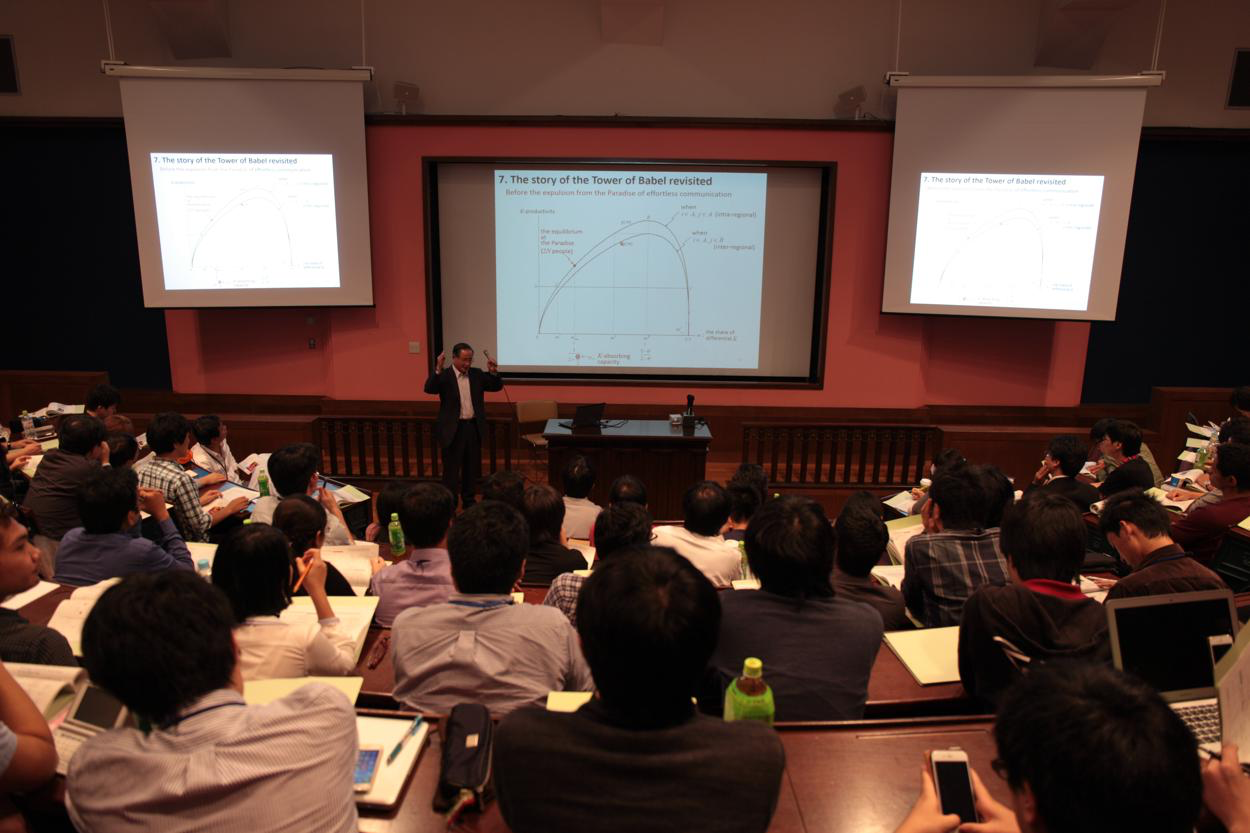 |
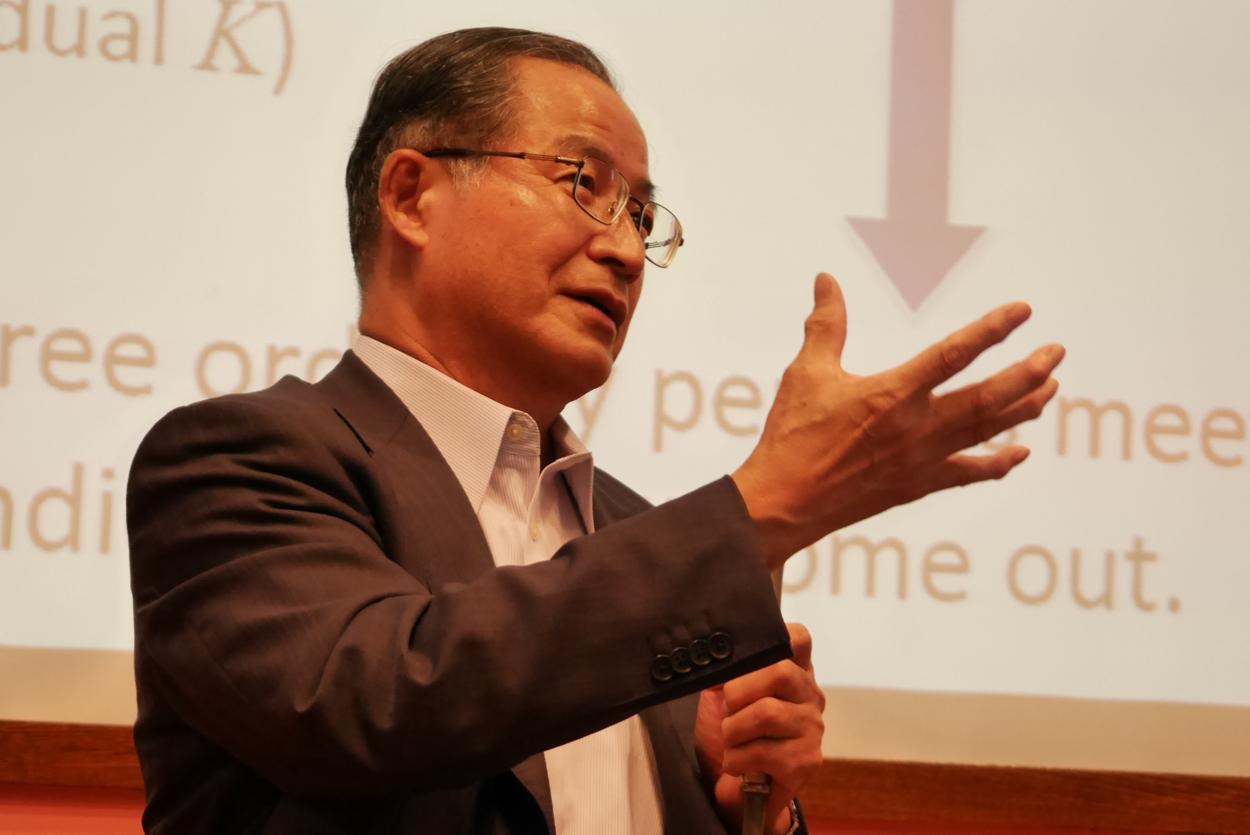 |
 |
|---|
Early Bird Session 1:
“Firms ELocation Choice based on Trading and Financing Relationship"
Ryo Fukuda (The University of Tokyo) [PDF]|
Mr. Fukuda had a presentation about firms Erelocation behavior based on trading and financing relationship. Historically, transportation costs have been decreasing and population have been concentrating to a few larger cities. However, now firm’s relocation is mainly moving locally to not only larger cities. To clarify the mechanism of relocations, he focused on continuous relationship of firms including trading and financing transactions. Using the database of Teikoku Databank, which is the largest credit research company in Japan, he analyzed firms Erelocation behavior, trading and financing network at first. Then, he applied nested logit model to explain location (municipality) selection and estimated parameters. As a result, the proposed model was more effective to relocation to medium-sized cities and of small & medium enterprises. |

|
|---|
Early Bird Session 2:
"Activity Opportunities and Changing Travel Patterns: A case of Developing Nations"
Varun Varghese (IIT Mumbai) [PDF]|
Mr. Varghese focused on activity opportunities and changing travel patterns, and presented the case study in India as a Developing Nation. The first part is about public transport crowding. In this part, he explained about the crowding of Ahmedabad city’s bus systems, and how to measure and calculate it. And in the second part, he focused on activity travel pattern in Mumbai. As the ICT technology has progressed, activity travel behavior of people who use mobile internet information can be changed. He proposed the framework to combine socioeconomic and spatial factors with ICT use in behavior modelings. And as the future work, he aims to develop an inter-regional destination choice model. It might be significant to better understand effects of policies related to long distance travel, such as infrastructure provisioning and facilities allocation, to activity opportunities. |
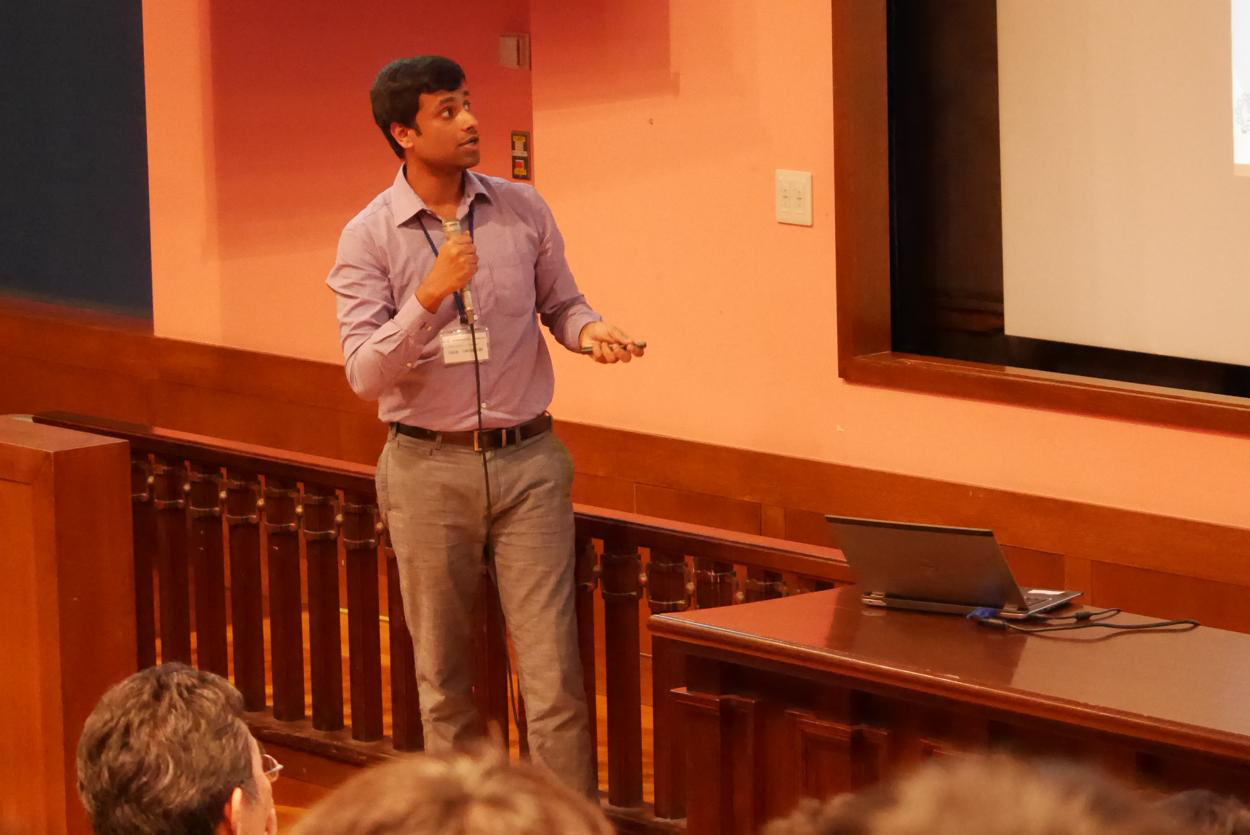
|
|---|
Early Bird Session 3:
"Context-Dependent Scheduling Model Considering Measurement Errors in Pedestrian Network"
Yuki Oyama (The University of Tokyo)[PDF]|
In pedestrian networks, activities can be generated context-dependently such as spatial attributes, social and activity interactions. To capture sequential decision making of pedestrians, Mr. Oyama modeled dynamic scheduling behavior based on the concept as energy, which is a personal resource for engaging activities and used as discrimination function of activity generation model. Using GPS data collected from Probe Person (PP) surveys in Matsuyama city, he stochastically inferred sequences of activities in pedestrian network considering measurement errors. In his model, walking links is assumed as an activity as well as staying at nodes, and these activities were connected with certain spaces through the bayesian approach. As a estimation result, it was clarified that the energy consumption and gain processes depend on some behavioral and spatial context variables. |

|
|---|
#05: "Modeling for evaluation of new urban transit and recent innovation in data-service technologies"(August 11, 2015)
The 5th International BinN research seminar, "Modeling for evaluation of new urban transit and recent innovation in data-service technologies" was took placed on Aug 11th, 2015. In this seminar, we mainly discussed the modeling for public transportation considering recent innovation in data-service technologies.
As keynote speakers, we invited Dr. Oded Cats from TU Delft and Dr.Jan-Dirk Schmöcker from Kyoto University. Dr. Cats is currently doing research on agent-based dynamic public transit modeling. And the keynote lectures focused on developed dynamic model and its application to real network. In addition, we discussed new approaches to new urban mobility modeling considering recent innovation of technologies.
Keynote Lecture 1: An agent-based approach to modelling public transport dynamics
Oded Cats (TU Delft) [PDF]The traditional PT assignment principle is frequency-based or schedule-based. This methods Eemerging developments are multi-agent simulation models, dynamic loading process, and so on.
Research question is how the system performs under various dynamic conditions. This study propose an agent-based approach to PTA. Agent-based TAM represents individual vehicles and travellers, agents Einteraction, en-route decisions and day-to-day learning. Implementation is BusMezzo. Using transit vehicle trajectory and traveller trajectory, transit modes and dwelling times are specified. The travel demand is represented by poisson arrival process. This simulation model includes non-compensatory rule-based choice-set generation process. En-route decisions are based on assessment of the attributes of each available path, and calculation of the joint utility.This model is applied for incleased capacity situation. For example, crowding factor is 3% at static model, but 60% in dynamic model. Based on Real-time information, the weakest path can be detected.
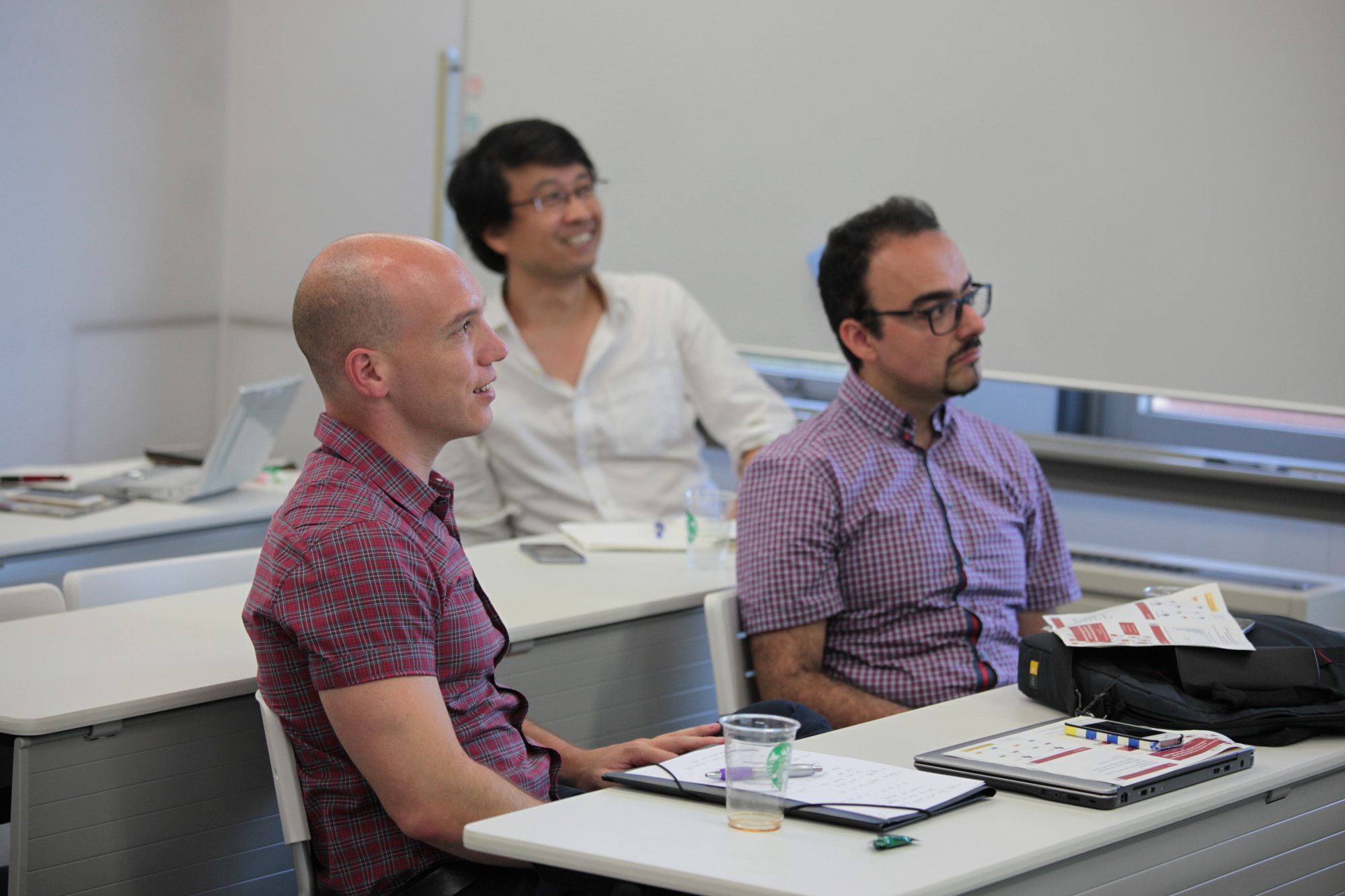 |
 |
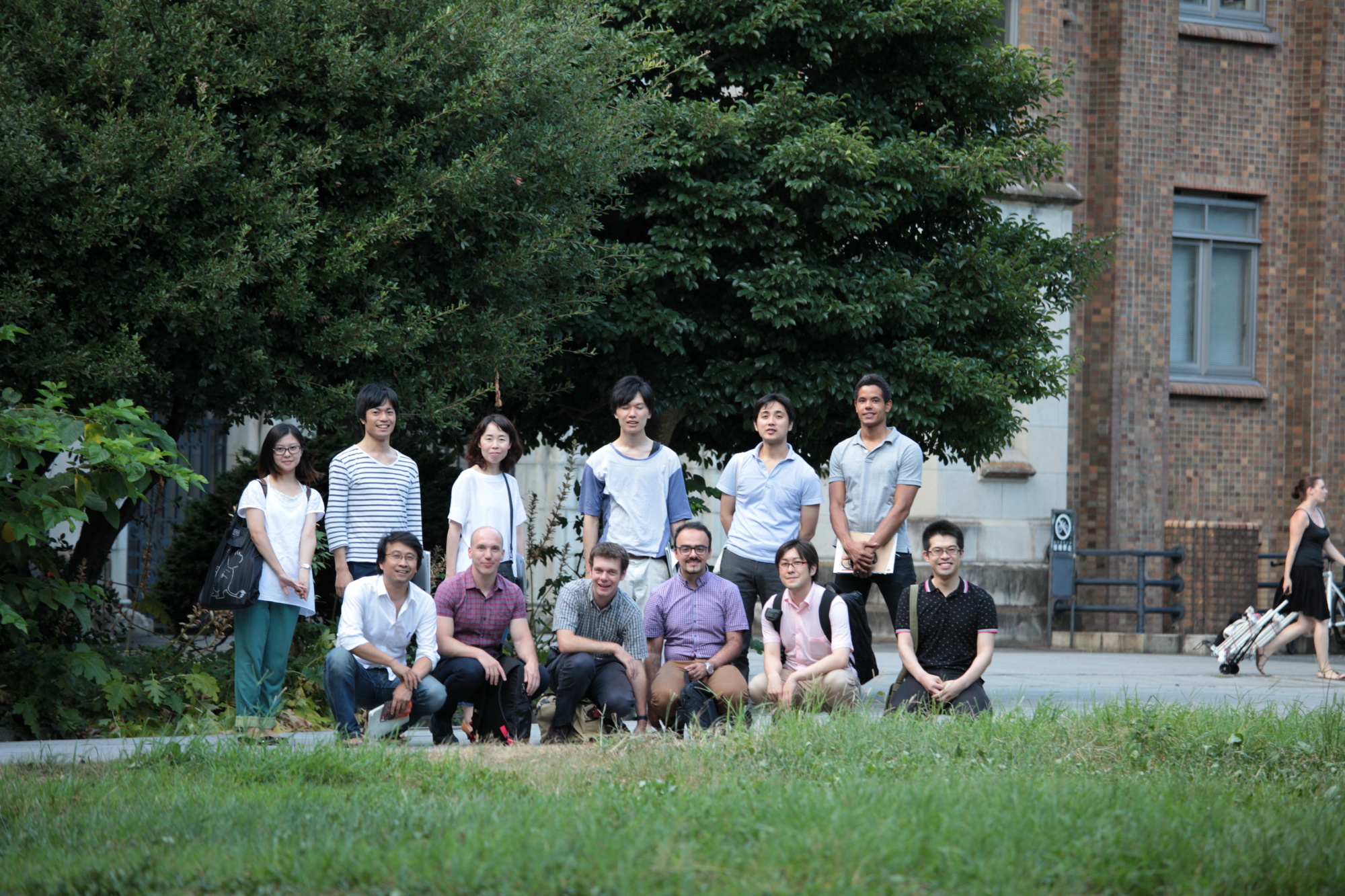 |
|---|
Keynote Lecture 2: Smart transit systems for even smarter travellers
Jan-Dirk Schmöcker (Kyoto Univ.) [PDF]|
Prof. Jan-Dirk Schmöcker provided a keynote lecture regarding smart transit with real time information considering bus bunching. Firstly he revealed why bus bunching arises when passengers have real time information (RTI). Because boarding rate is influenced by travelers given RTI, even without exogenous delays bus bunching arises. Secondly, he transformed classic route choice problem with hyperpaths formulated by Spiess and Florian into multiple local demon game assuming risk-averse users and demons aiming to maximise delay. And then based on it, a smart transit with RTI in bus services can be transformed into single local demon game. Not only with formulations but also with actual effects, it was shown that the travelers behave in different ways at each departure point depending on how much well informed in advance they are. In conclusion, in smart transit which gives “good Einformation to travelers, they can benefit from it. However, there is also a risk that the system can be outsmarted by the travelers. Therefore, even more information and management of network may be required. |
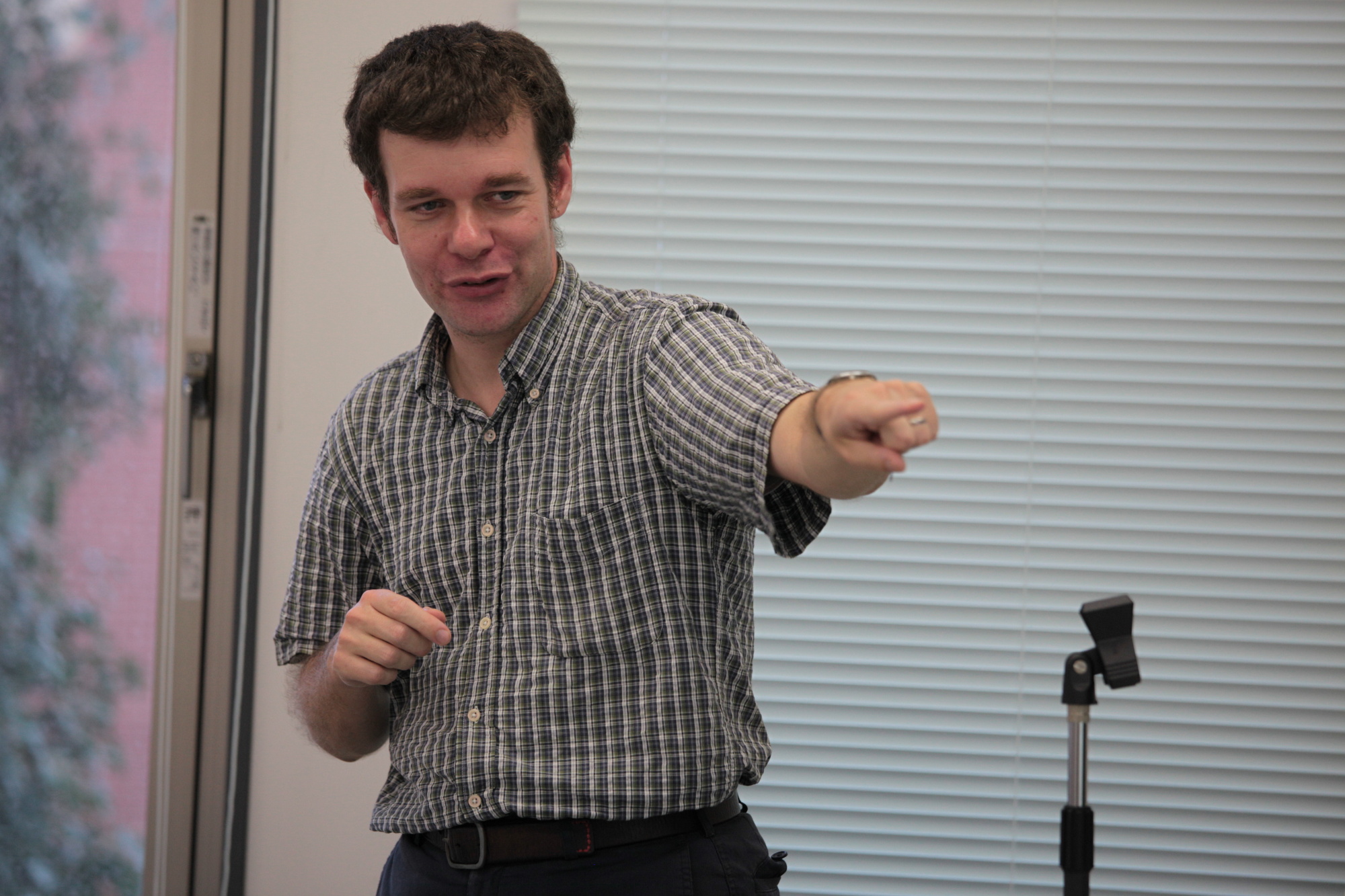
|
|---|
Research Presentation 1:
"Innovative ITS Approaches for Control of Large-Scale Urban Networks"
Mehdi Keyvan-Ekbatani (TU Delft) [PDF]|
Dr. Keyvan-Ekbatani focused on gating control, which is a practical tool for mitigating congestion in urban networks, and evaluated its efficiency using network or macroscopic fundamental diagram (NFD or MFD). When gating is located upstream of protected network (PN) to keep the network under-saturated, time-delay to approach PN is induced. To deal with time-delay, Dr. Keyvan-Ekbatani proposed the developed feedback regulators, and tested gating performances using this concept. In experiment in urban network of Chania (Greece) and San-Francisco, the results showed that gating strategy acted efficiently and leads to significant improvements in mean speed and delay at the overall network level. |
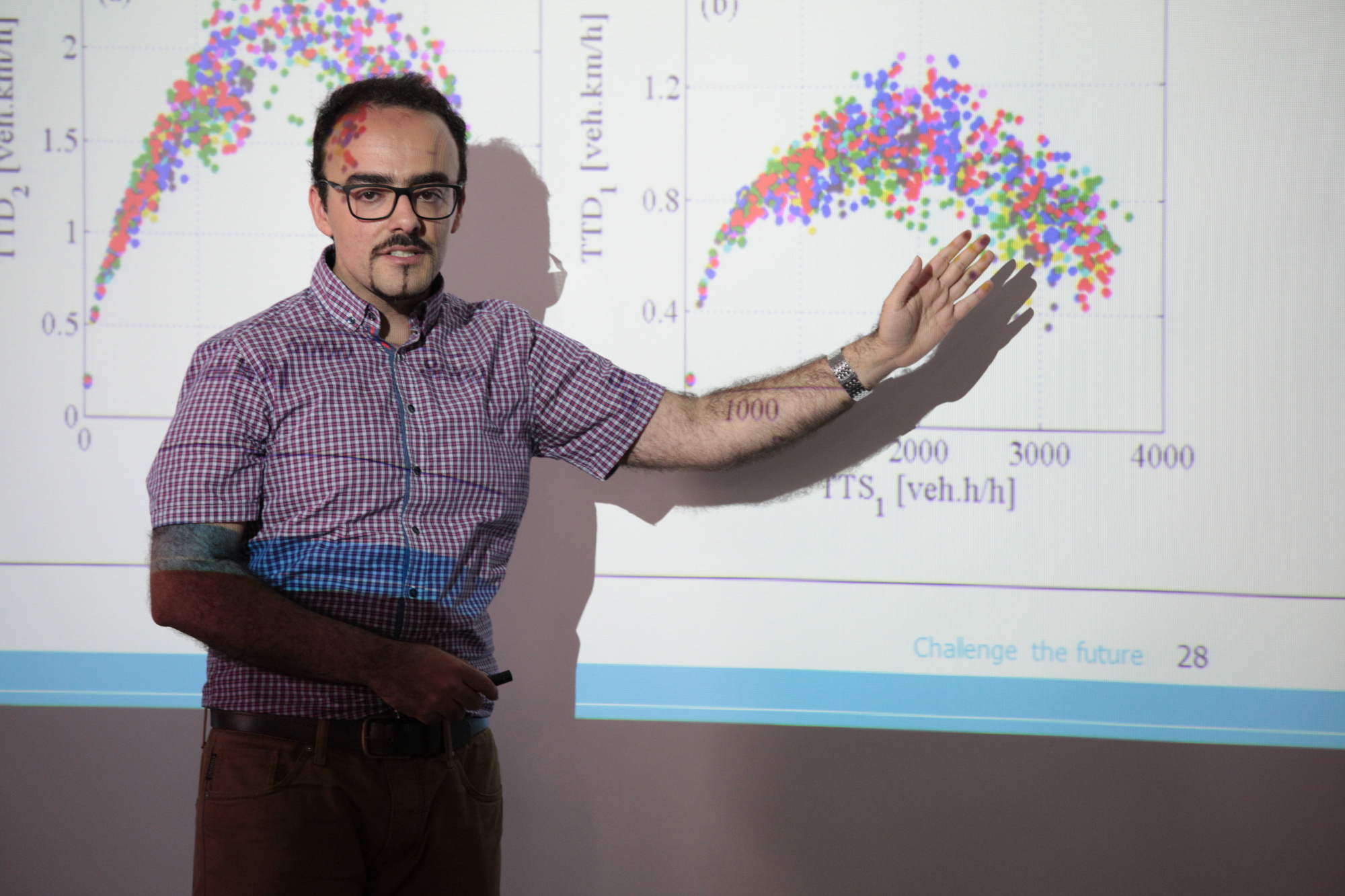
|
|---|
Research Presentation 2:
"Demand control management for one-way car sharing system focus on the imbalance between demand and supply"
Nodoka Kasahara (Tokyo Univ.) [PDF]|
Ms.Kasahara’s research focused on the Demand control management for One –way Car sharing service named “Choi-mobi Eby applying price optimization. By using Probe Person data that is activity diary and trajectory data by GPS, and use result data, she formulated the profit maximization problem by changing the price of this service. In this formulation dynamic programming method was applied. As a result of the numerical example, it was confirmed that price control have effect for the demand control. Furthermore micro simulation was calculated considering the availability of service in the real network in Yokohama, Japan and evaluate the pricing strategy. |
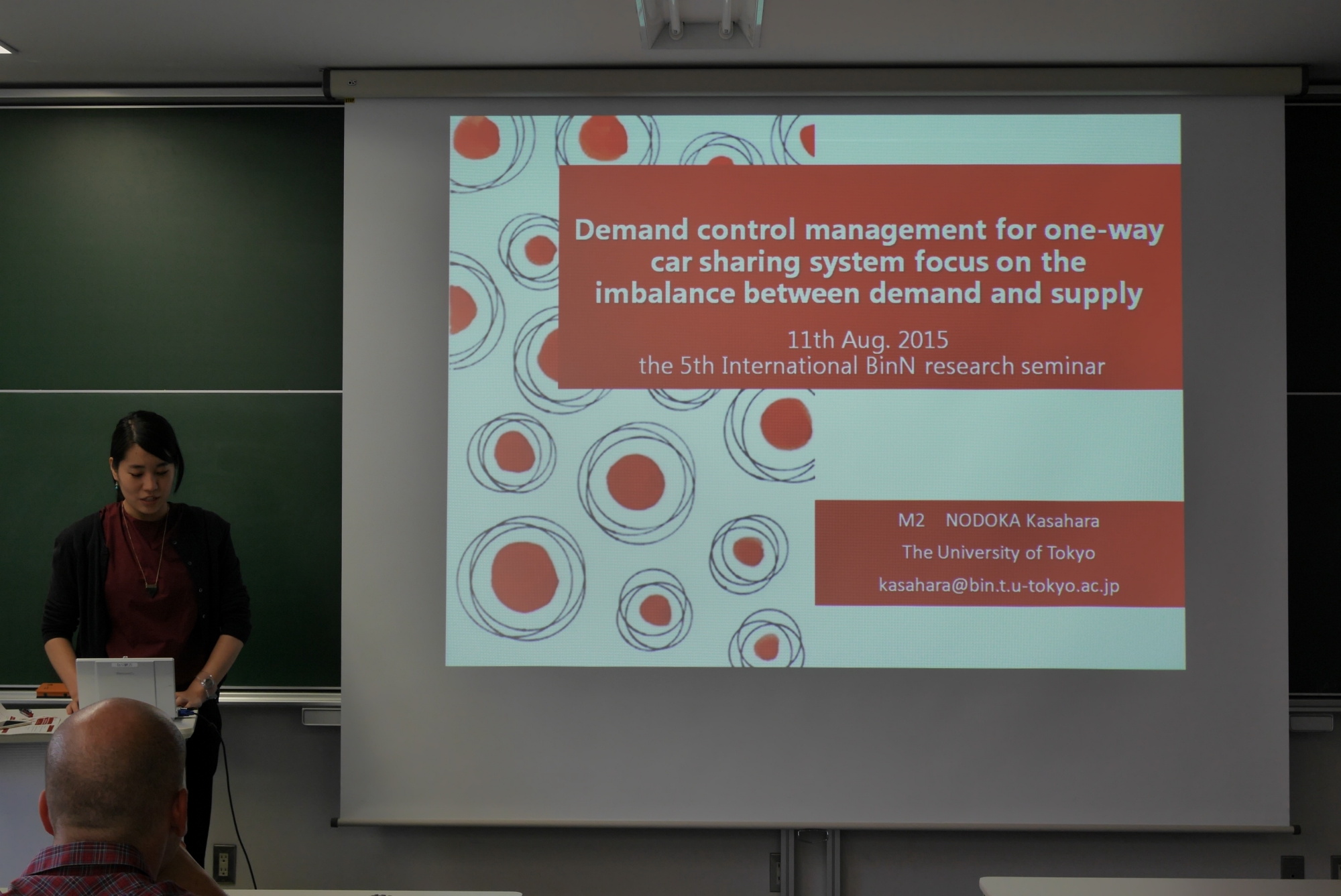
|
|---|
#04: "Dynamic modeling based on bounded rationality to understand diversifying travel behavior"(June 13, 2015)
Although much progress has been made over the years, the basis of current transport models is still the rational-agent model. This traditional view is regarded to lead to numerous biases in the description of human behavior. In this seminar, new approaches to travel behavior modeling based on bounded rationality are discussed, particularly focusing on how to accurately represent the decision making context and process. In addition, this seminar aims at discussing about methods for integrating new data and technologies into models.
In this seminar, as keynote speakers, we will invite Dr. Theo Arentze from Eindhoven University of Technology and Prof. Morikawa from Nagoya University. Dr. Arentze is currently doing research on dynamic activity-based modeling involving human cognition and learning. The keynote lectures will focus on bounded rationality in individual decision making, and its implications for policy making. In addition, two invited researchers will discuss new approaches to disaggregate behavioral modeling.
Keynote Lecture 1: The role of bounded rationality in travel choice behavior and implications for transport modeling
Theo Arentze (Eindhoven University of Technology) [PDF]In travel demand models, micro simulation models based on the activity-based approach have been developed from early 19 century. These are developed from static to dynamic and including social networks and interactions based on new survey methods and data sources, for example GPS data. He incorporates bounded rartionality in travel demand models. The model with bounded rationality are composed of 3 steps of cycle, learning & judgment, search & information acquisition, and evaluation & decision. In these 3 steps, biases are well-documented, such as memory biases, limited search, and emotional weighting.
He proposed new modeling approach using habitual behavior and spatial search. From a dataset of an agent’s set of scripts, He defined utility of a script. This is composed of activity component and travel component. An agent choose the script that maximizes utility. If agents are dissatisfied with current set of scripts, then the agent starts exploration. The probability that a location is specified as logit model using conditional probability used ρE ρErepresents lack of information. Effect of memory and emotion is represented by a model of memory encoding and retrieval processes. This model explains primary and secondary biases.
 |
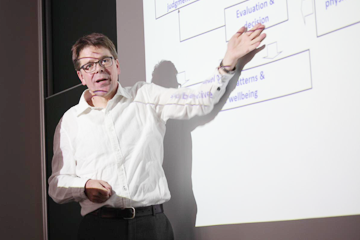 |
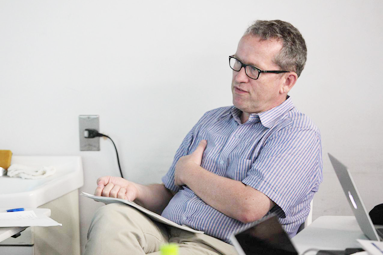 |
|---|
Keynote Lecture 2: Bounded rationality in travel behavior modeling
Takayuki Morikawa (Nagoya University) [PDF]|
Professor Morikawa’s lecture focused on the bounded rationality in travel behavior modeling and decision making strategies. First, he gave an overview of the three types of rationality and 6 type of decision-making strategies. Then, he showed the framework for the bounded rationality with latent classes. Furthermore, two case studies were introduced. First one was about the mode choice between car and dynamic P&R using a semi-ordered lexicographic rule including both compensatory and non-compensatory decision making rules. Second one, more psychological approach, was by applying mental accounting theory, he aimed to analyze the effect of Ride Point Program in the context of discrete choice travel behavior. |

|
|---|
Research Presentation 1:
"Modeling shopping behavior in a neighborhood with endogenous representation of retail attractiveness"
Makoto Chikaraishi (Hiroshima University) [PDF]|
Dr. Chikaraishi developed a model of shopping behaviour in a neighbourhood with social interactions. It shows retail attractiveness as endogenous. The important point of this model is to deal with market/non-market interactions not through “average Ebehaviour but through “aggregate Ebehaviour. This model is estimated by NFXP algorithm. By using this model, an empirical analysis was performed using 10 networks in Hiroshima city. It confirmed significant endogenous effect but it did not give multiple equilibrium. Main point in the discussion part is whether new elements can be applied to that model or not, such as history/strategy of supply side (i.e. supermarket), interactions on floor space and average/personal income information. Since the available data is limited and developing the estimation method is difficult, it is challenging but possible to fulfil some of the requirements. |
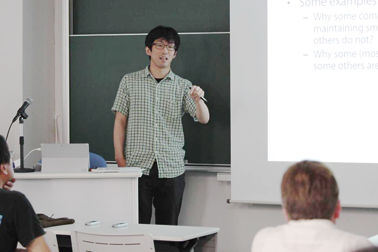
|
|---|
Research Presentation 2:
"Choice set generation of pedestrian route choice using data distribution of walking behavior in urban space"
Sachiyo Fukuyama (National Institute for Land and Infrastructure Management) [PDF]|
Dr. Fukuyama proposed a data-oriented approach for choice set generation of pedestrian route choice behavior. In this research, she applied Branch and Bound (Prato and Bekhor, 2006) and sampling method using data distribution from the probe person surveys. Branching rules in her study consist of destination directivity, keep-direction rate and detour rate. She concluded this approach is able to be applied for individual choice set generation which reflects the characteristics of individual behavior when they have enough amount of trajectory data. |
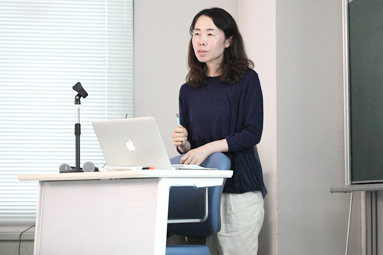
|
|---|
#03: "Network configuration and multi-scale behavior analysis"(March 4, 2015)
The optimal spatial scale of analysis of travel behavior differs given the target behavior of interest. As a result, modelling travel behavior in micro, meso and macro scale is necessary to adequately analyze and evaluate transportation networks. In addition, scale aggregation is sometimes necessary not only to match the scale at which spatial recognition is conducted by individuals, but also to reduce calculation costs. This seminar aims at deepen the discussion regarding the relationship between spatial configuration and travel behavior in a multi-scale framework.
In this seminar, we invited Dr. Richard Connors from the Institute for Transport Studies (University of Leeds). Dr. Connors is currently doing research on network equilibrium and topological configuration of transportation networks.
Keynote Lecture: Ensemble Analysis of Transport Networks
Richard Connors (University of Leeds) [PDF]Dr. Connors focused on the relation between network performance and topology, and sought to answer the question: How does network topology structure affects network performance (e.g. efficiency, vulnerability)? To investigate this relation, among a set of possible indicator variables, he applied the concept of “Meshedness Eas a single variable summarizing network topology, and “Price of Anarchy EPoA) as a performance indicator. PoA is defined as the ratio of the Total Travel Cost (TTC) under User Equilibrium (UE) routing to the TTC under Stochastic Optimal (SO) routing.
Connors examined network performance across a wide “spectrum Eof networks in order to understand the relation between PoA and network size, density, and connectivity. In addition, he tried to undesrtand how PoA depends on demand, and concluded that the variation of PoA with travel demand is due to activation of routes at different levels of demand under UE and SO (route activations is defined as increase in the number of links which are used caused by demand increase).
 |
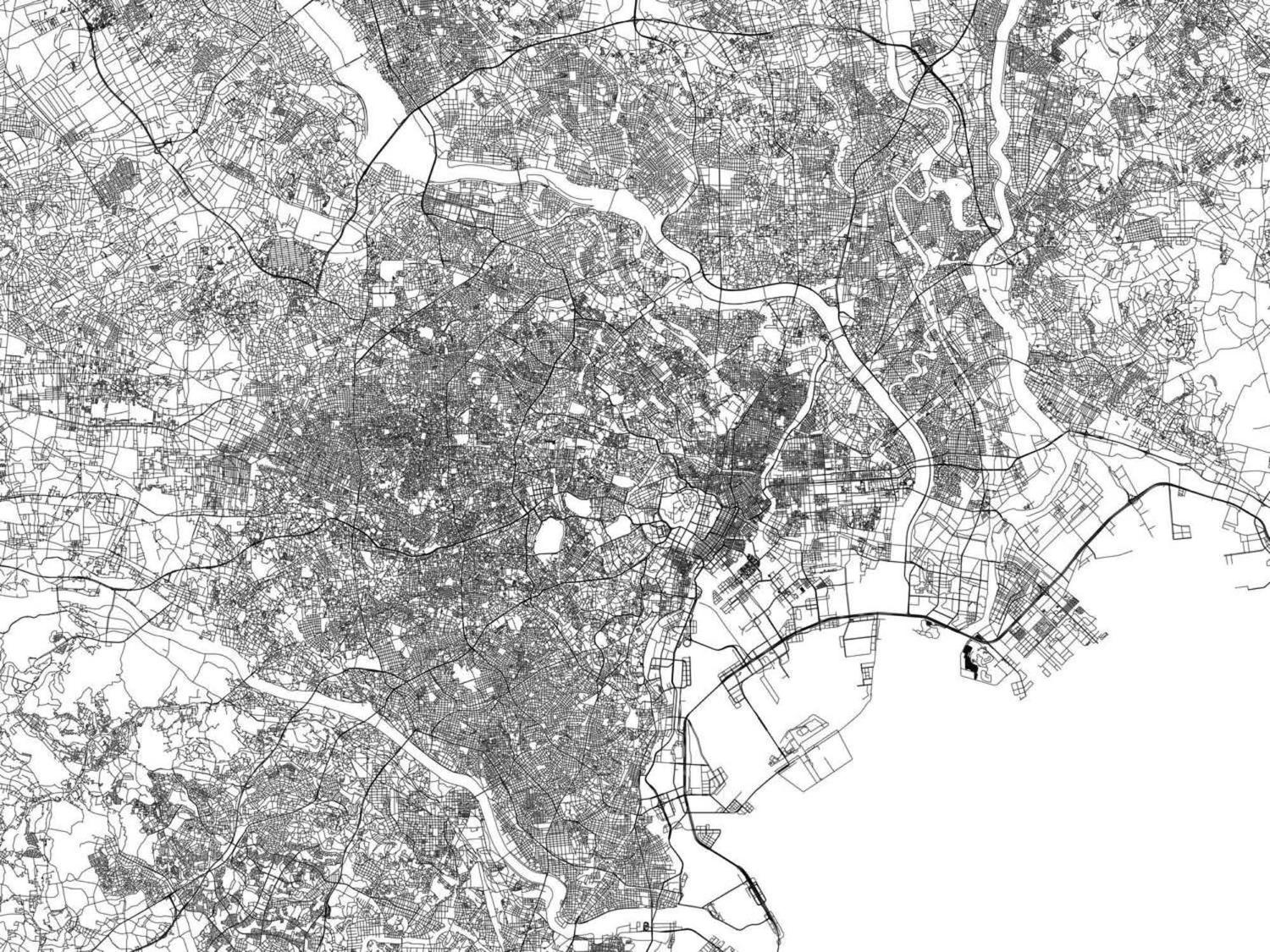 |
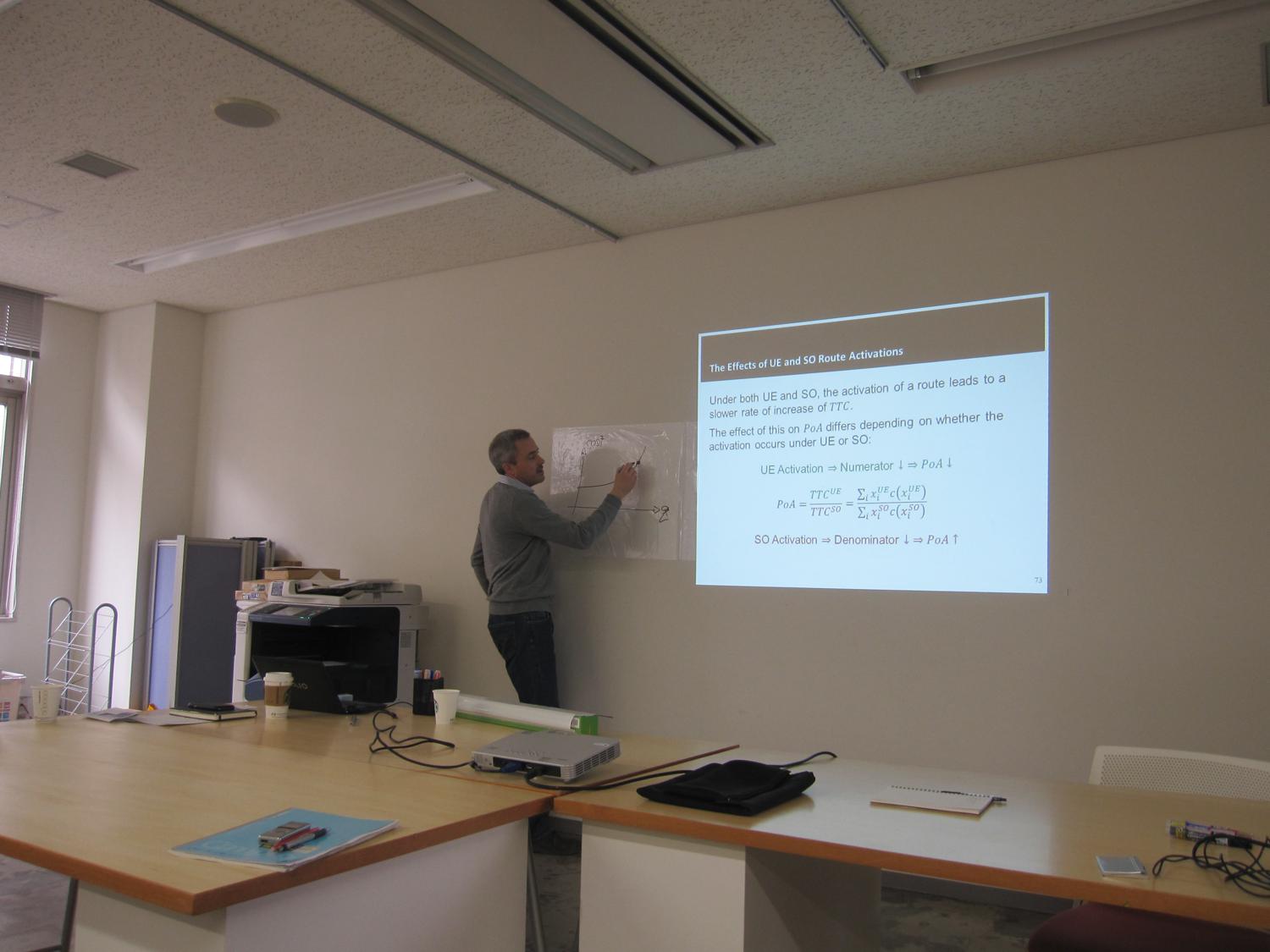 |
|---|
Research Presentation 1:
"An experimental study of driving behavior of Personal Mobility Vehicles"
Miho Iryo-Asano (The University of Tokyo) [PDF]|
Personal Mobility Vehicles (PMVs) have high potential as an intermediate mode between walking and cars. However in most cases PMVs are of limited use, such as in the airports, shopping malls, golf courses etc. This preliminary study analyzed conflicts between pedestrian and PMVs, In particular, how did PMVs users avoid pedestrians. In this experiment, a Robstep M1 vehicle was used (Max speed is 15km/h, Min Speed is 9km/h). Position data was gathered through video monitoring, while an android app was used to measure wheel speed. 30 monitors conducted 24 tries each. It was hypothesized that the PMV will travel along the shortest path (timewise) and adapt his behavior to avoid the coming pedestrian in two ways: by changing its direction angle, or adjusting speed. Preliminary findings suggest that all else equal, rear avoidance is preferred to front avoidance. |

|
|---|
Research Presentation 2:
"A joint estimation model of destination choice and evacuation timing: Case study of Kesennuma City"
Giancarlos TRONCOSO (The University of Tokyo) [PDF]|
The analysis of travel behavior under disaster situations consists mainly of three main stages 1) evacuation participation and departure time choice 2) Destination choice and 3) route choice. Although there is enough evidence to suggest that these phases are interdependent, due to model complexities most studies model these phases independently. This presentation focused on this gap in the literature by proposing a discrete-continuous model of Tsunami evacuation destination choice and evacuation timing. Data from the Great East Japan Earthquake is used to estimate the model. Travel behavior data from the day of the earthquake was gathered by the Ministry of Land, Infrastructure, Transport and Tourism (MLIT) of Japan via a travel diary. In terms of the methodology used, based on the premise that both outcomes might in fact be jointly determined, a discrete-continuous model is formulated. Destination choice is formulated as a multinomial logit model, where the choice set is generated as a function of location altitude in order to account for tsunami risk. Evacuation timing is estimated as an accelerated failure time survival model. Results validate the use of a discrete continuous approach as several error correlation parameters were statistically significant. Among factors found to affect destination choice were OD distance, OD altitude difference, which is estimated as a quadratic function, average slope of destination and total number of buildings in destination. Regarding evacuation timing, significant variables include the use of car for evacuation, altitude at origin knowledge of refuge locations, and age. |
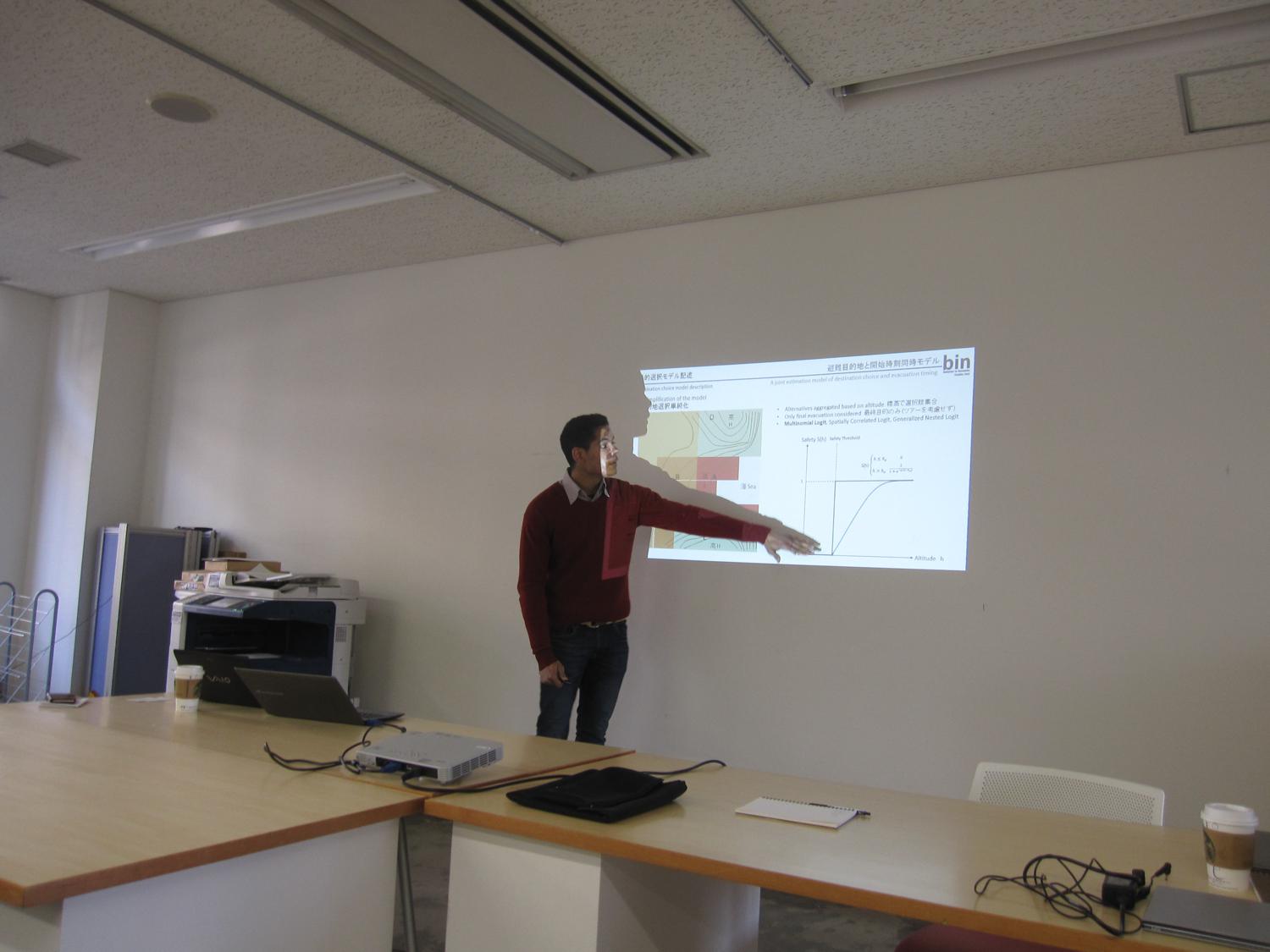
|
|---|
#02: "Advanced activity model for capturing dynamic changes"(Sept 27-28, 2014)
In this decade, activity-based models based on a succesive choices have become progressively popular. Activity-based models are able to illustrate and evaluate personal activities and their traffic environment. The models have been implemented for various policy applications. In this seminar, we invited Prof. Shlomo Bekhor, from the Israel Institute of Technology, who specializes on behavioral models, transportation planning and network optimization.
Keynote Lecture: Stability analysis of Activity-Based models
-Case study of the Tel Aviv Transportation Model-
Shlomo Bekhor (Israel Institute of Technology) [PDF]
Professor Bekhor’s lecture focused on the issues regarding practical implementation of Activity-Based Models (ABM). The lecture was divided into two parts. The first part departs from the advantages of implementing Activity-Based Models over the traditional 4-Step approach. The first part of the lecture introduced the model implemented in Tel-Aviv City, in Israel, which is based on the hierarchical model proposed by Bowman and Ben-Akiva (2001).
The second part of the presentation focused on the stability of ABMs, which is a critical issue on these type of models due to its probabilistic nature (As opposed to the deterministic nature of the 4-Step model). Professor Bekhor pointed out to three main sources of error that might compromise the stability of the ABMs, namely, assignment accuracy, the random component in the tour generation models, and the population sampling.
Regarding, assignment error, as in previous studies, assignment errors can be eliminated using path-based assignment algorithms. Regarding tour-generation randomness, averaging results of model runs might be successful in mitigating error. Finally, regarding, population sampling, instead of sampling from the population, Professor Bekhor recommended using the full population, as sampling does not bring any significant savings in the number of iterations (as more iterations are required to converge), and might compromise the accuracy of ABMs.
To conclude, one of the most important limitations in ABMs might come from the uncertainty in the synthetic population generation, which is created from a limited set of aggregated control variables.
 |
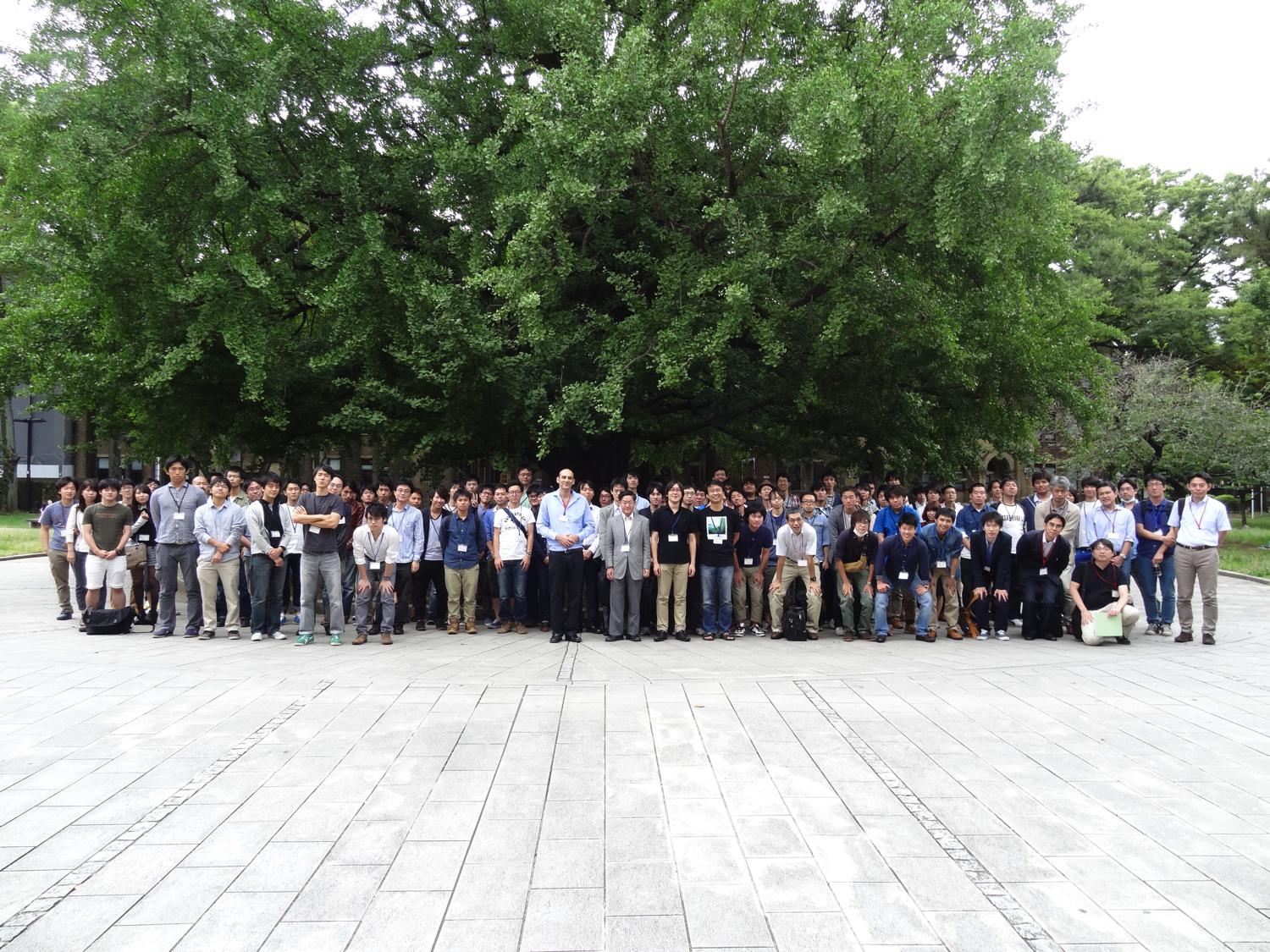 |
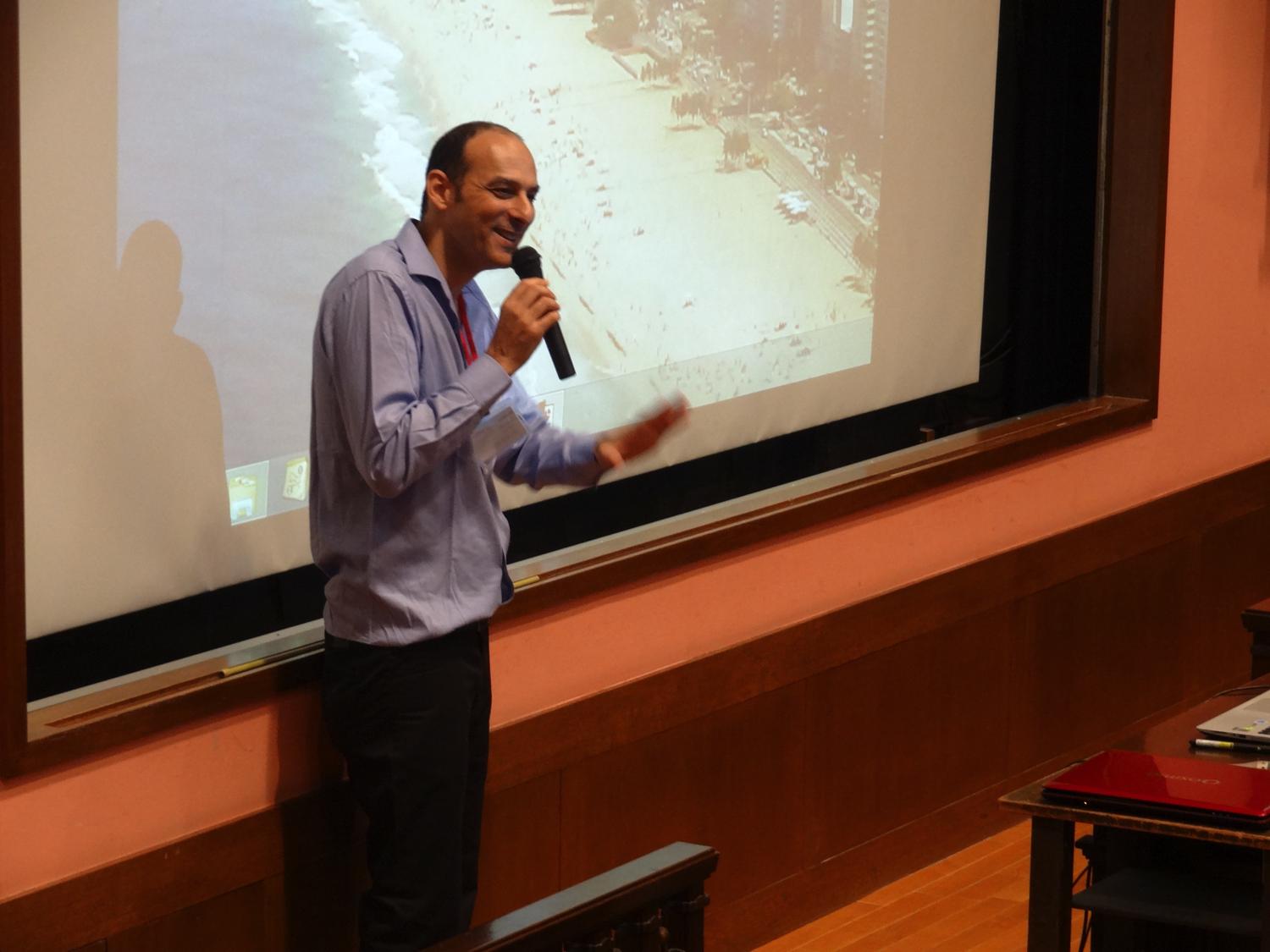 |
|---|
Early Bird Session 1:
"Transportation system monitoring method by using probe vehicles that observe other vehicles"
Toru SEO (Tokyo Institute of Technology) [PDF]|
Mr. Seo’s presentation is aim to acquire volume-related info over a wide range, and proposes a new method for estimating traffic states using probe vehicles with spacing measurement equipment. Then validates the method under an actual condition in Tokyo. Mr. Seo reports that high resolution information can be acquired where enough number of probe vehicle exist. And mentions a system model of microscopic travel behaviors and pedestrian space as future works. |
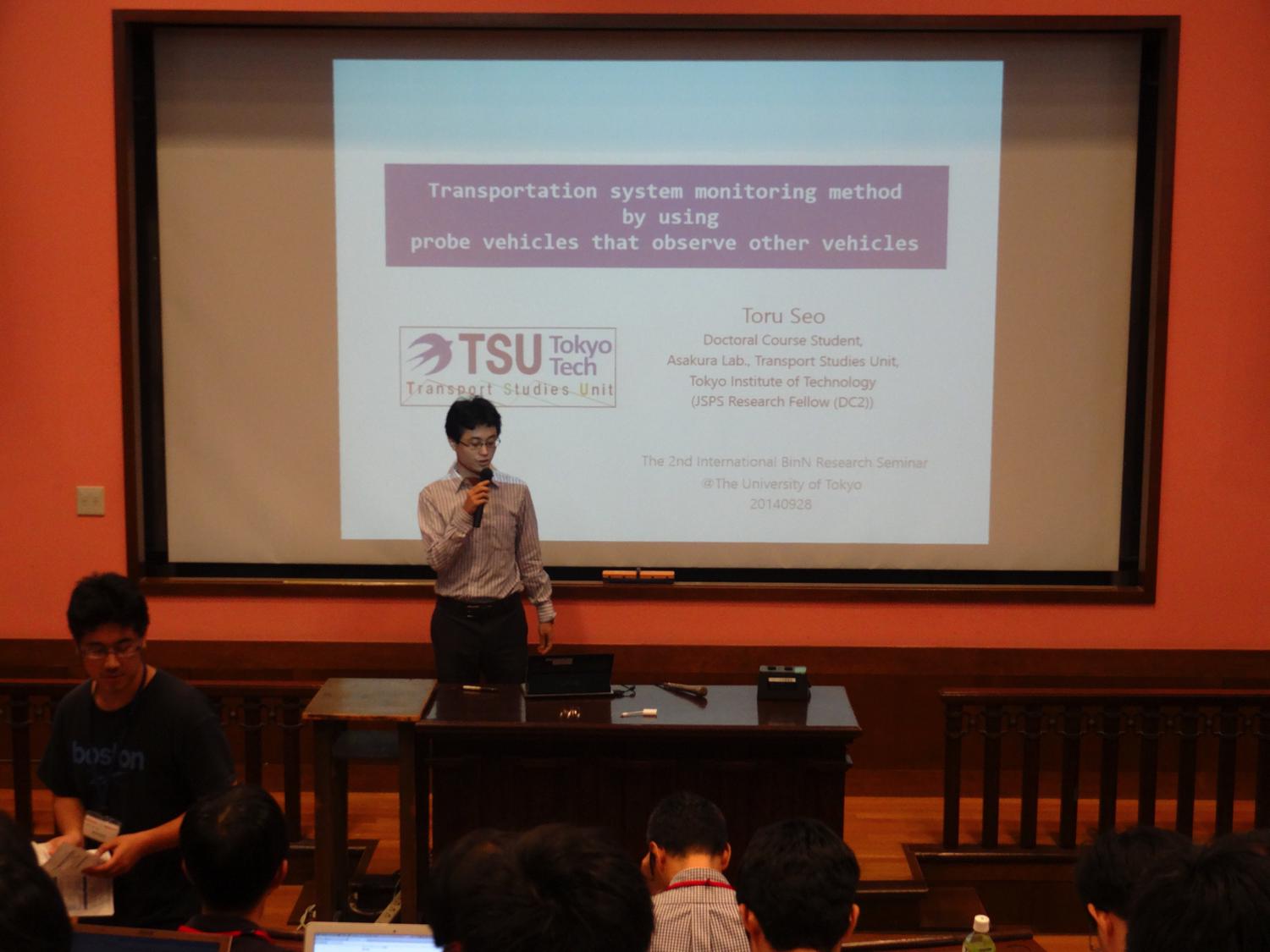
|
|---|
Early Bird Session 2:
"The built environment-travel behavior connection: A propensity score approach
under a continuous treatment regime"
Giancarlos TRONCOSO (The University of Tokyo) [PDF]|
In recent years, the concept of urban development is changing into which promote the population concentration to cities center, like a compact city, from a viewpoint of the breakaway from the society of automatic automobile dependency. However, it is not clarified about the causal relationship which built environment gives to traval behavior of individuals and households. This is because the right causal effect cannot be explained in cross-sectional data since selection bias occurs by the background covariates of a specimen. To overcome these limitations, Dr. Troncoso had an eye to the "propensity score" approach (Rosenbaum and Rubin, 1984). This score is the conditional probability of treatment given observed covariates and can explain the causal effect which eliminated the selection bias. This approach is originally used under binary treatment regimes, but can be generalized under continuous treatment regimes (Imai and Van Dyk, 2004). |
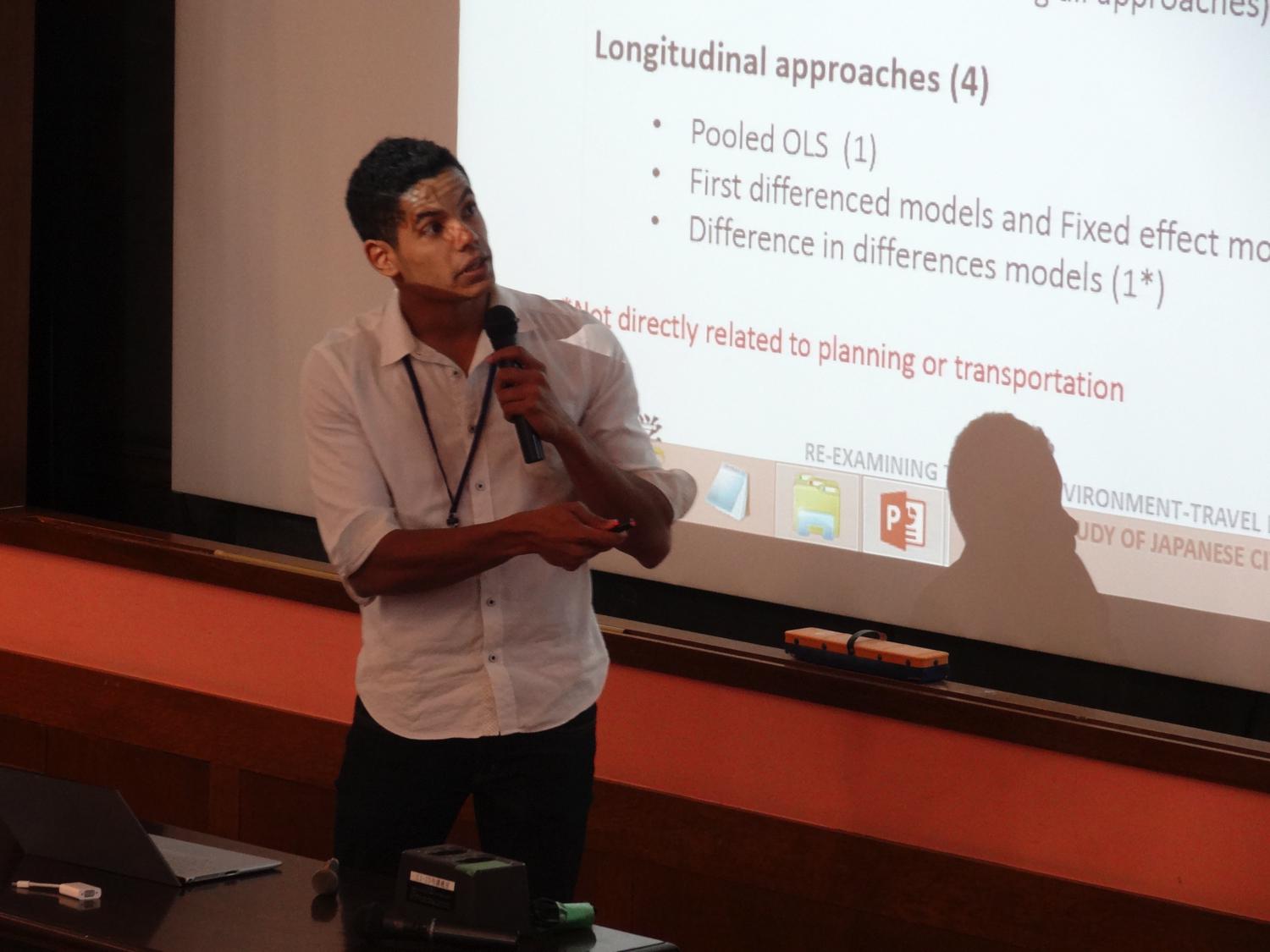
|
|---|
Early Bird Session 3:
"Accommodating spatial correlation in local-interaction formation model under a heavy rain disaster"
Junji Urata (The University of Tokyo)[PDF]|
This study focus on making interactions under a disaster in a settlement. An interaction between two people is influenced not only by two but also by others in group. The process of making interactions are modeled as a group decision-making. This model capture a spatial correlation of interactions. The correlations arise from spatial risks and travel costs. The correlations are formulated by spatial divisions. The model structure is a network-GEV model (Daly & Bierlaire(2006)). In this study, a case study is shown. The utility of making interactions are set by a altruistic utility which is a difference of risk. |
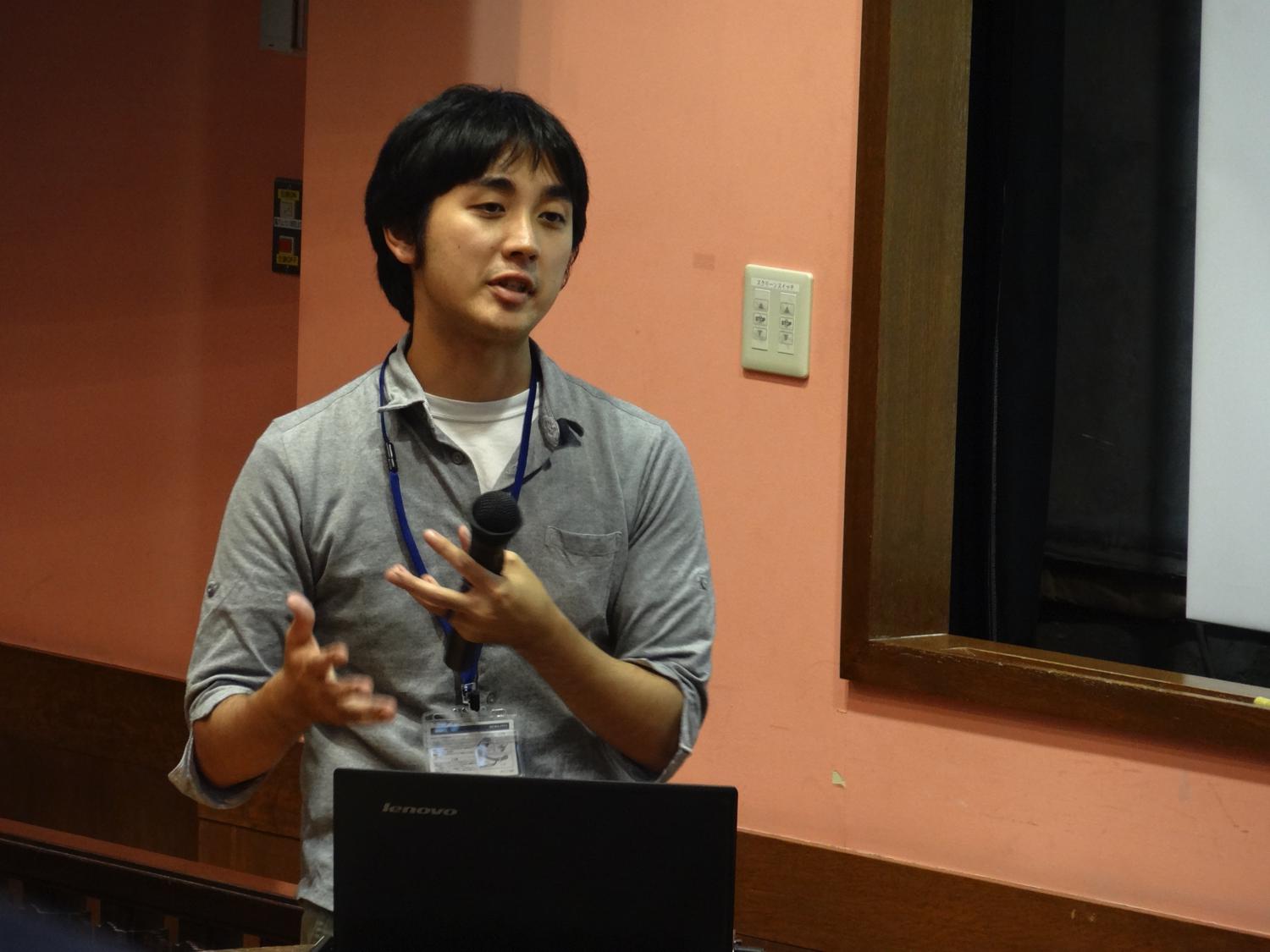
|
|---|
#01: "Dynamic Travel Behavior Modelling for Evacuation"(July 12, 2014)
In Japan, many local government prepare for infrastructure of disaster reduction and many people study on disaster reduction after the Great East Japan Earth quake(2011). In the world, the evacuation behavior studies attracts attention after Sumatra-Andaman arthquake(2004) and Hurricane Katrina(2005). We need the citizens' evacuation behavior analysis, the evacuation traffic management by information technology and the road network design for evacuation.
In this seminar, we invited Dr. Pel, who is a young researcher and study on evacuation behavior and talked about dynamic travel behavior modelling for evacuation. Dynamic management and forecasting are needed for optimal evacuation because travel time are limited under disaster situation. We discussed about the direction of thesis of evacuation behaviors and managements.
Keynote Lecture: Route choice Behavior and Optimal traffic management in Evacuation
Adam Pel (TU Delft) [PDF]Dr. Pel's lecture gave an overview about the research efforts at TU Delft focusing on improving route choice behavior and traffic management during evacuation situations. Dr. Pel explained that in terms of evacuation research, the key challenge is the development of theory and models to predict evacuation behaviors, incorporating factors such as how people react to disaster information and evacuation instructions, and taking into consideration uncertainty in parameter estimation. Certainly uncertainty is a crucial aspect when discussing evacuations, as travelers are not familiar with emergency situations, they might behavior changes due to stress and emotions, and infrastructure may be affected by disaster.
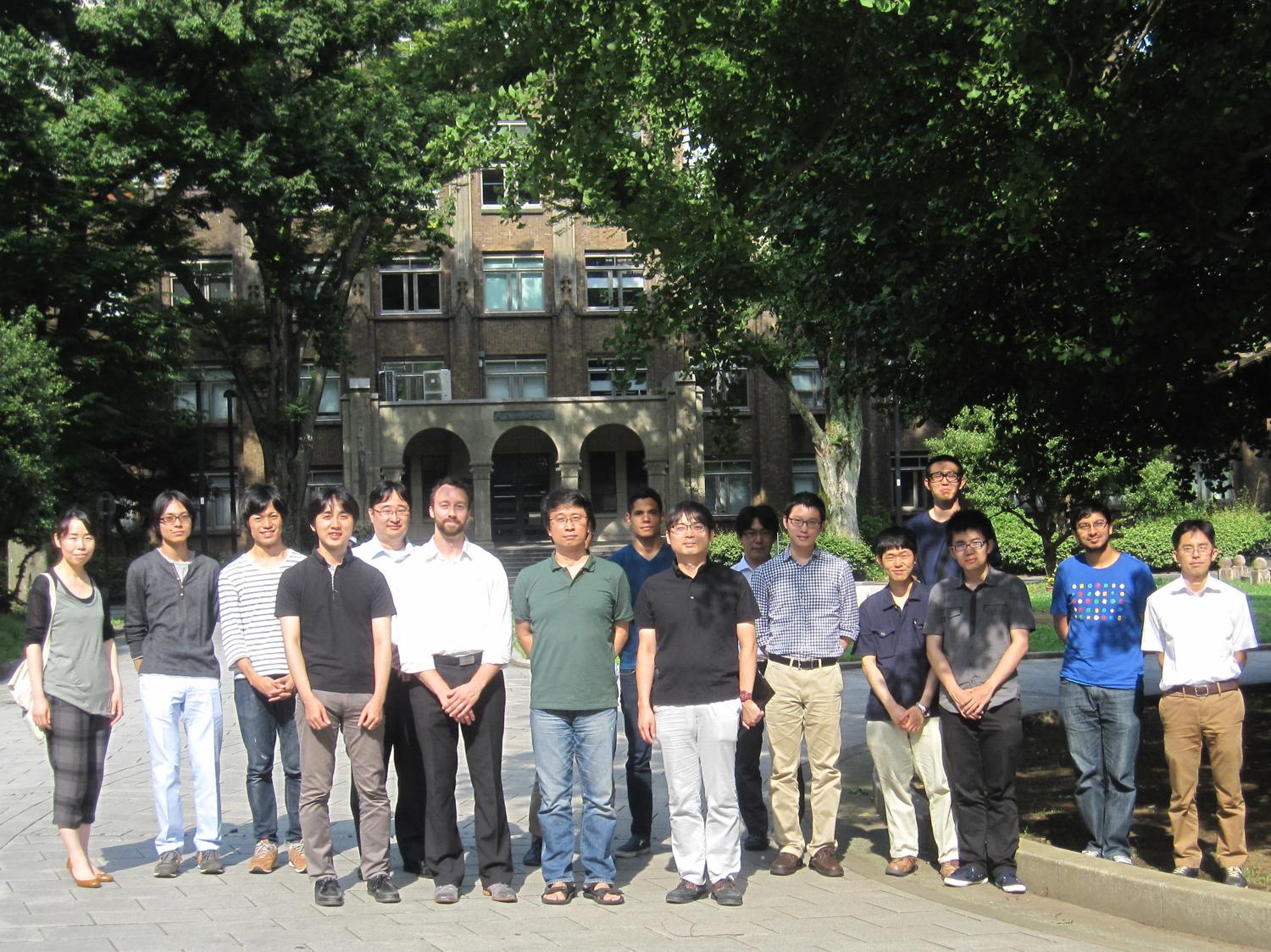 |
 |
 |
|---|
Research presentation 1: "Direction of evacuation traffic"
Takamasa Iryo (Kobe University)|
Dr. Iryo's presentation discussed the issue of traffic evacuation directions using the Great East Japan Earthquake as a case study. The presentation challenged the assumption of a unique destination used in Dynamic Traffic Assignment (DTA) for evacuation analysis. Dr. Iryo argued that in the case of disasters trip purposes can in fact be heterogeneous, because the only purpose is not evacuation. This paper was tested using evacuation data from some cities in Tohoku during 3.11. Findings in fact suggested that the direction of evacuation trips was quite clear (homogeneous), but also showed the existence of other trips such as picking up family members, that are rather heterogeneous. |
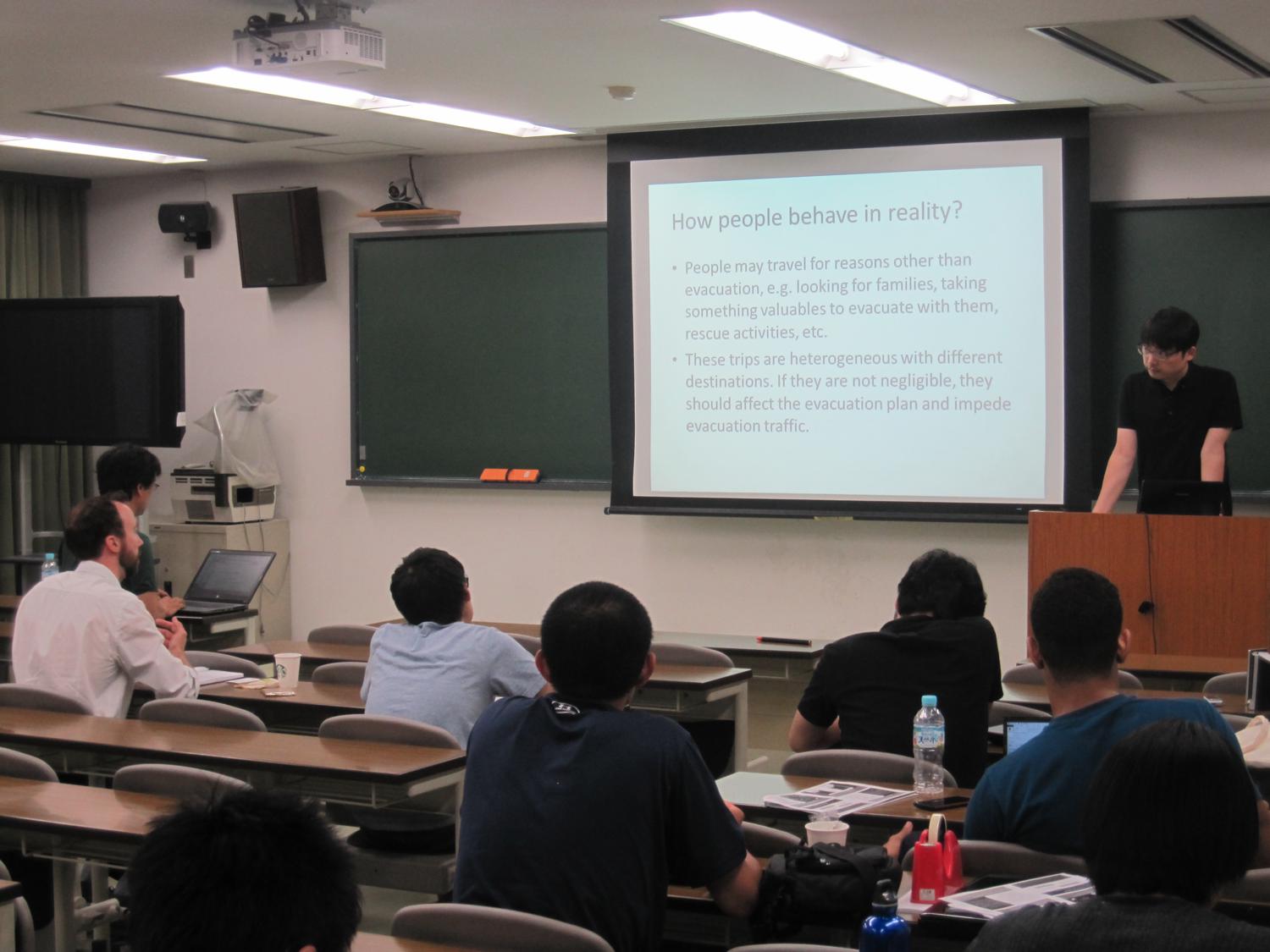
|
|---|
Research presentation 2: "A Dynamic Discrete Choice Model of Collective Behaviors incorporated in Spatial Reference Group under Disaster Situation"
Junji Urata (The University of Tokyo)[PDF]|
Mr. Urata’s presentation focused on understanding collective behavior during disaster situations. And explain how to use a dynamic discrete choice modelling framework to understand the process of collective behavior formation. Mr. Urata further argues that collective behavior predictions can be helpful in developing an efficient local evacuation management plan and an adequate information propagation system. |
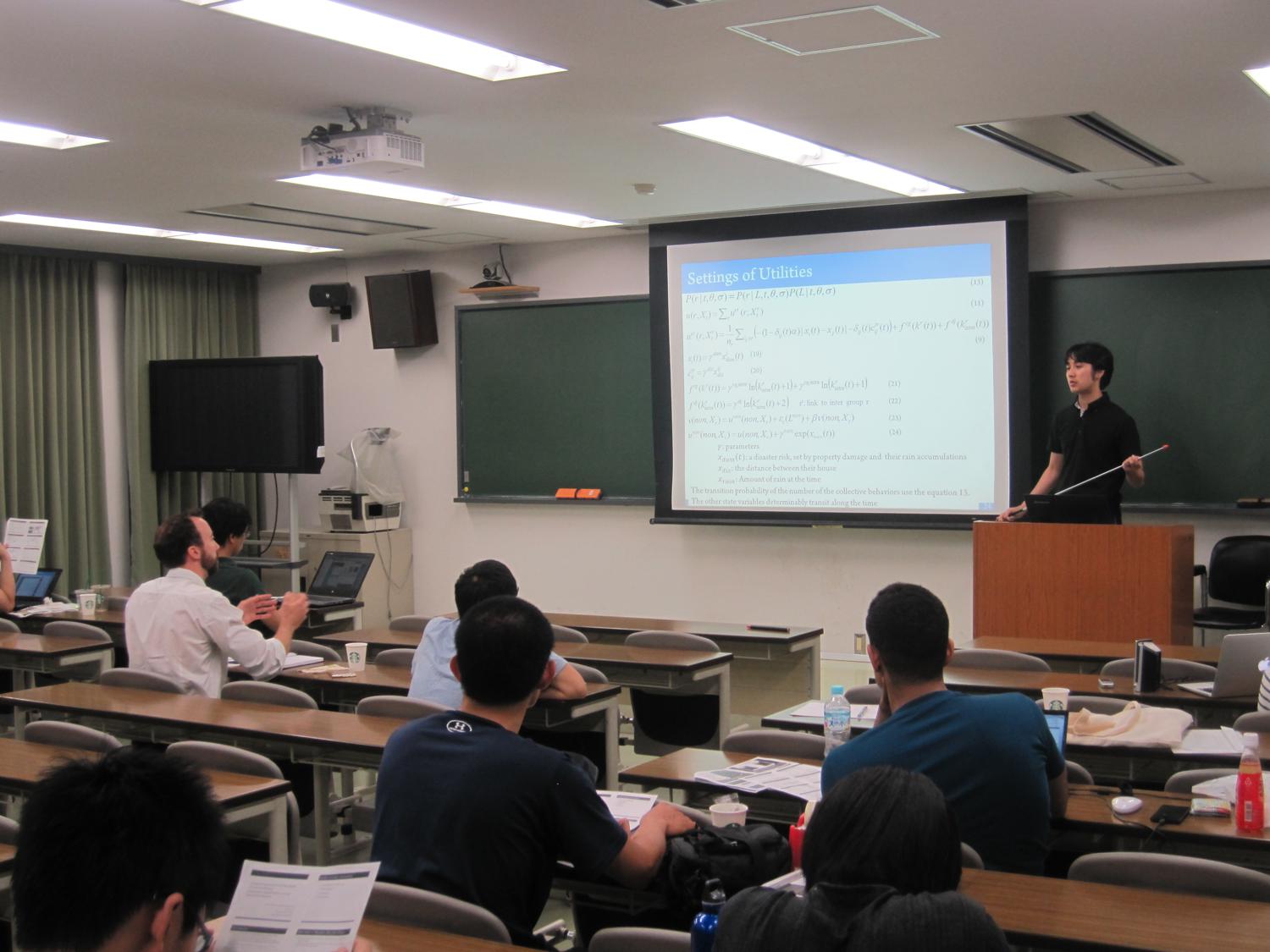
|
|---|